History of Lake, Porter, and LaPorte, 1927County history published by the Historians' Association . . . .
Source Citation:
Cannon, Thomas H., H. H. Loring, and Charles J. Robb. 1927.
History of
the Lake and Calumet Region of Indiana, Embracing the Counties of Lake,
Porter and LaPorte: An Historical Account of Its People and Its Progress
from the Earliest Times to the Present.
Volume I. Indianapolis, Indiana: Historians' Association. 840 p.
HISTORY OF THE LAKE AND CALUMET REGION OF INDIANA
CHAPTER XXVI.
CITIES.
MICHIGAN CITY -- LAPORTE -- VALPARAISO -- HAMMOND -- EAST CHICAGO -- WHITING
-- CROWN POINT AND HOBART -- GARY -- THE EARLY DAYS OF GARY BY HON. ORA L.
WILDERMUTH -- EARLY RECOLLECTIONS OF GARY BY COL. A. P. MELTON -- HOW WE
INCORPORATED THE TOWN OF GARY BY HON. C. OLIVER HOLMES.
686
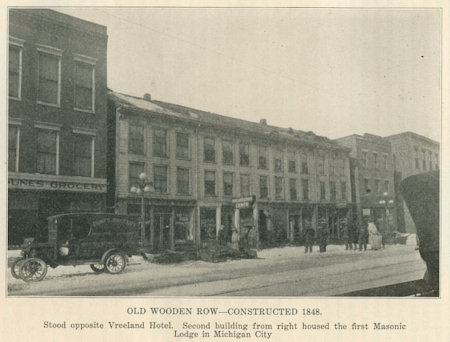
687
MICHIGAN CITY.
The purchase of the original site of Michigan City by Major Elston, a land speculator and promoter, in 1830 for $1.25 per acre has been described in another chapter. The first log cabin was built by Jacob Furman and Benjamin Bryant in 1832 and the best evidence indicates that this and another cabin were occupied by Samuel Miller and Joseph C. Orr during the winter of 1832 and 1833. The probability of Michigan City becoming a great lake port for trade and commerce early attracted attention to it so that in 1833 a number of families settled there and developments were rapid. The Michigan Road was laid out and good road communications soon existed between Michigan City and LaPorte.
Trail Creek furnished water power for mills which were soon in operation, the wheat supply being received from the surrounding country. The number of mills increased as the farming territory became more developed and it is claimed that in 1847 there were thirteen flouring mills in operation. In the first few years of its existence and until the panic of 1837 Michigan City enjoyed a greater growth in population and business than any of the pioneer communities in the Lake Region, and even the panic year was only a temporary hindrance to the growth of the town, as it soon recovered from the depression of that year and not a business house in Michigan City failed during the panic period.
Efforts to improve Michigan City harbor began during the early pioneer period and through a joint resolution of the General Assembly of the State of Indiana in 1831 requesting the governor to apply to the secretary of war for a corps of engineers to make a survey of the mouth of Trail Creek and through a later resolution passed by the Legislature in December, 1832, asking Congress directly for an appropriation for the
688
erection of a light house and the construction of a safe harbor at the mouth of the river, great hopes were entertained by Michigan City citizens that it would soon develop into a large thriving community.
Through the efforts of Congressman Edward E. Hannegan, who submitted the General Assembly resolution to Congress with a second resolution of his own asking the committee on roads and canals to inquire to the expediency of making an appropriation for the above purpose and through another resolution submitted by Congressman Jonathan McCarty of Indiana asking the Committee on Commerce to inquire into the expediency of making Michigan City a port of entry, action on the part of the government soon took place and on October 10, 1834, Lieut. John N. Berrian with Lieutenant Fetterman as his assistant were instructed to execute a survey of the mouth of Trail Creek to ascertain the possibilities of improvement and the practicability of constructing a safe and convenient harbor. The report of the engineers showed that the harbor possibilities of the mouth of Trail Creek were superior to any other section of the shore of Southern Michigan, south of Grand River, and after overcoming considerable opposition in both the House and the Senate, an appropriation of $20,000 was made available after July 14, 1836, to begin the harbor improvements.
It was too small an amount to start with and for many years insufficient appropriations retarded the work of harbor development so by private subscription $100,000 was spent by Michigan City citizens and others between 1863 and 1867, when the harbor again came under control of the government. Among the contributors to the $100,000 expended on harbor development were John Barker, H. H. Roberts, D. J. Baldwin, L. A. Stimpson, William Schoenemann, Vice President of the United States Hendricks, the Louisville, New Albany and Chicago Railway and a long list of small subscribers. Even in the later years of the past century when lake traffic had developed to enormous proportions, Michigan City did not receive the proper consideration it should have had in order to make possible the greatest development in lake transportation and commerce. One important result of the harbor development was to make Michigan City a great lumber market, millions of feet of lumber being available on the upper lake, and it will continue for years to be a great source of supply.
A large per cent of the amount originally spent in harbor improvement was pure waste and it is said that much material rotted on the shore for lack of money to install it in place. There is now an inner and outer harbor and the greater part of the total expenditures of approximately $2,000,000 including repairs was on the development of the outer harbor. The first vessel which ever entered Trail Creek from the lake was a little schooner called the Sea Serpent, which crossed the bar on July 4, 1836,
689
and was an additional reason for making our great national holiday an occasion of great rejoicing.
Michigan City was incorporated by an act of the Legislature passed February 8, 1836, and at the time-of incorporation had an area of about fifteen square miles, which was to be considered as one ward until 1842, when it was to be divided into not less than three nor more than five wards and each ward to have two members in the council. The first
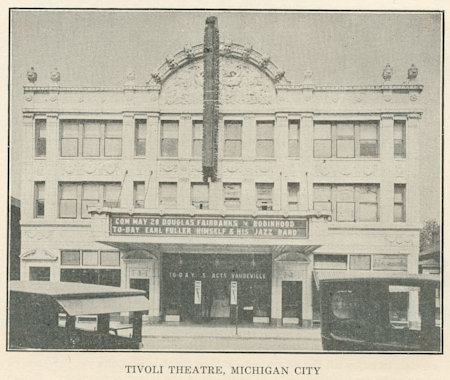
mayor was Willys Peck, the first recorder Caleb B. Frisch, and the first treasurer Francis C. Good. The city slowly but steadily increased in population and business and modern methods of city administration and conduct were introduced and modern improvements installed, until today Michigan City is a thoroughly modern municipality and a well governed city.
The Michigan Central Railroad entered Michigan City in 1852, making connection with Detroit and the East, to the great joy of the inhabitants and very early thereafter the road established connection with Chi-
690
cago. The railroad was a great stimulus to business and travel and it was not long until by way of the Monon Route, connection was established with Southern Indiana and farther south. The Indianapolis, Peru and Chicago Railroad (now the Lake Erie & Western), was completed to Michigan City in 1871, which with the other roads gave the city excellent communication for that period. In 1903 the Pere Marquette began to operate trains into Michigan City and with the electric traction and city lines in addition to the steam railroads, Michigan City is well favored with transportation facilities.
Passenger and freight steamship service has been developed in a large way on the lake and during the open season a large freight and passenger business is conducted between Michigan City and the principal lake ports. Michigan City now has a population approaching 30,000 and its location is near the center of population in the United States. It is a clean healthy city well lighted and progressive. There are four banks with approximately $10,000,000 of assets and every legitimate enterprise is given aid and encouragement by these institutions. Low water and rail freight rates exist and it is an important trade center. It has an up-to-date fire department well equipped with modern motorized fire fighting apparatus and a personnel with a record of efficiency, and the insurance rates are therefore low.
Michigan City has a particularly healthful location and the health of the citizens is carefully looked after, the death rate being one of the lowest in Indiana. The city is now well drained and during the year 1925 over $850,000 was spent in sewerage construction. Gas and electric power rates are from five to fifteen per cent less than cities of similar size. It is the terminus of the great steel district of Indiana, which includes the south shore of Lake Michigan from Hammond east. Seventy-five per cent of the people in Michigan City own their own homes and there has never been any serious labor trouble. There is an abundance of skilled and unskilled labor available and manufacturers have contented employees.
Only an hour and twenty-five minutes by rail from Chicago it is near enough to enjoy all the advantages of the great metropolis yet far enough away to be free of the high cost of living in the larger community. Better rail, electric and water transportation facilities would be difficult to obtain. The city has just been selected for the Great Lake terminus for a line of European boats conveying European clay, pulp, woods and other products for use in the central states and cargoes of American products will be carried on the return voyages to Europe. There are approximately forty miles of paved thoroughfares and more than eighty per cent of the streets have sidewalks. It has the largest number of paved streets of any community of the same size in the United States.
691
It is one of the few cities which has the local five cent carfare with excellent local transportation facilities. There are seven hotels, the principal one being the new Hotel Spaulding, owned by the citizens of Michigan City and one of the finest hotels to be found in this county in any city uder 100,000 people. Nearly all the church denominations are represented in the city and there is a fine Y. M. C. A. building and equipment. In addition to the various local organizations nearly all the national orders are represented and the Elks have one of the finest homes to be found in any city of similar size. The city is enjoying a solid substantial growth and during the year 1925, 422 permits were issued for building construction amounting to more than $1,000,000.
The city has an excellent system of water works with a thoroughly modern pumping equipment. A study of the record of the police department for 1925 shows that by comparison with other cities of similar size the morals of Michigan City are relatively high and its police department very efficient. Chief Kruse is recognized as an exemplary official and the conduct of the department could not be improved. The postoffice receipts for calendar year 1926 were $96,000. The assessed valuation of the city is approximately $24,000,000, and the government is by city commission with Albert R. Counden as city manager.
For 1926 the city commission was Carl J. Ahlgrin, John H. Boss, William F. C. Dali, Harvey L. Odell and Christopher G. Wilber. The present mayor is William F. C. Dali; city clerk, Edward J. Hise; city judge, Fred H. Mitchell; city attorney, Walter C. Williams; director of finance, William H. Billings; city treasurer, William H. Fink; city engineer, Wade H. Swasick; chief of fire department, Irvin C. Bauman; superintendent of police, Richard J. Kruse; superintendent of parks, August Koehn.
In view of the great expansion of the industrial area on the south shore of Lake Michigan in which Michigan City is certain to share in the not distant future, plans for a future city with large population has been in the minds of the citizens with the result that a city planning commission was appointed consisting of C. E. Arnt, president; Dr. J. J. Kerrigan, C. J. Ahlgrin, John M. Lambka, Martin Karpen, W. W. Pepple, H. P. Levin, William F. C. Dali and W. W. Swasick, city engineer. Lawrence V. Sheridan was selected by the commission as consultant engineer. Recommendations for streets and thoroughfares, parks, playgrounds, boulevards, schools, revision of transportation lines, a civic center and zoning have been made by the commission and preparations for the future needs of the city will be carried forward.
Already some of the industrial corporations in America have secured land on the lake shore not far from Michigan City and the likelihood of great industrial plants and magic cities arising over night nearby seems
692
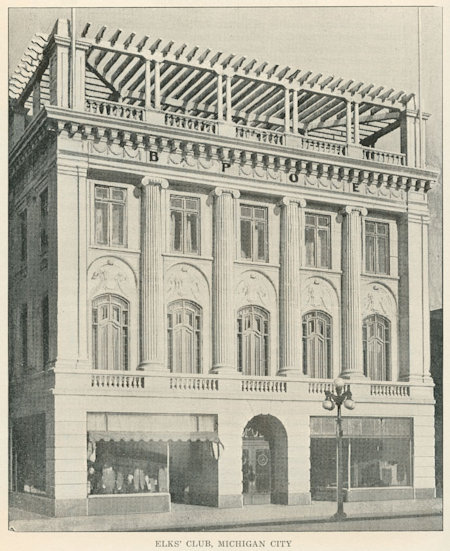
693
likely, while in and near Michigan City are important shore areas with all the advantages for industrial development associated with the shores of Porter and Lake counties. It seems safe to say in view of its location and advantages Michigan City seems destined for a great future.
INDIANA STATE PRISON.
In 1858 an act was passed by the Indiana Legislature to provide a new state prison to be located north of the National Road and in 1860 the commissioners appointed to locate the prison decided in favor of Michigan City and it was completed in 1861. For a great number of years the prison has been self-sustaining or nearly so with an occasional call on the state to make up deficiencies. The oldtime methods of discipline
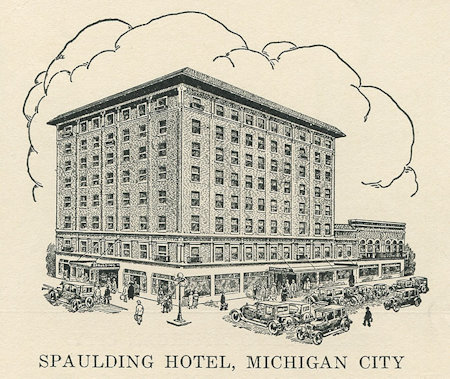
which made convicts hopeless wrecks and with nothing before them but a criminal life when released was long ago discarded for new humane methods of treatment, with educational advantages and inspiration and hope to the convict, so he may be restored to society as a law abiding self maintaining citizen, in many instances with a trade which will insure him a livelihood when released.
The Michigan City State Prison is a model institution in the treatment and reform of the criminal. The merit system installed permits the well behaved and ambitious convict to obtain educational advantages in the institution which opportunity may have been denied him before his confinement. His physical health is carefully considered, his mental ability studied, and work is provided whenever possible for which he is best adapted and to the credit of society generally the released convict is given a chance to prove his mental and moral worth and many former
694
convicts of the Michigan State Prison occupy positions of merit and responsibility since their release from confinement.
Under the administrations of Warden Reid and Warden Fogarty, the institution became known all over the country for its perfect discipline under most humane and sympathetic administration and its rules of discipline and methods of conduct have been adopted in a large measure in other prison institutions throughout the country and the indeterminate sentence and parole system gives hope to the prisoner which experience has shown has been a great incentive to the convict to redeem himself. Under Walter H. Daly, who succeeded Warden Fogarty, the methods of discipline and treatment have been continued and the institution in many ways has made greater progress than before. Warden Daly has given
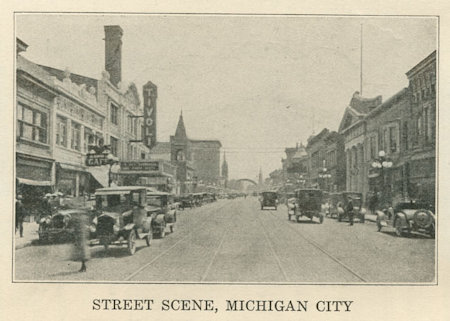
special attention to the development of the Hoosier Binding Twine Mills, which are a part of the prison and under his management.
The Hoosier Mills were started in March, 1906, in a small structure close to the present plant. The site today is a three story brick building, a model factory, well lighted and ventilated, and each department has been systematically laid out with ample floor space allotted to the various departments. The machinery is of the most modern type for the purpose and has been so arranged that crowding has been eliminated, thus assuring the utmost skill in the workmanship involved in each process. The plant manufactures binding twine for harvest fields and has 200 spinners. The factory is equipped to turn out rush orders in a short time and this service has been depended upon frequently where quick action was necessary to complete contracts. Warden Daly is acquainted with a host of twine salesmen and having learned their requirements in this line, he instituted the policies of high grade material and workmanship and
695
respect for the experience and opinions of customers. As a result the product is in great demand and the success of the Hoosier Mills reflects great credit on Warden Daly’s management.
LAPORTE.
The favorable location of LaPorte City was the determining factor in its development into a large prosperous community as it was directly in the natural path of travel from East to West through the county, the territory around LaPorte being open and comparatively level while north of it was the rugged, hilly, sandy section avoided by travelers and on the

south was the almost impassable Kankakee swamps. The soil was productive and the location was of an appealing character to the early settlers and later it became the natural route for railroads, affording easy grade with no construction difficulties and the heart of the agricultural section, the soil being easily tilled and the products of which were an attractive source of revenue to the railroad.
Even before the period of white settlement, where LaPorte now stands was a camping ground for both Indian and white travelers and two famous Indian trails crossed this favored section. That it should appeal to A. P. and James Andrews as a desirable site for a city was natural in view of its location and surroundings and when once established its growth was rapid. The decision to make LaPorte the county seat was a great factor
696
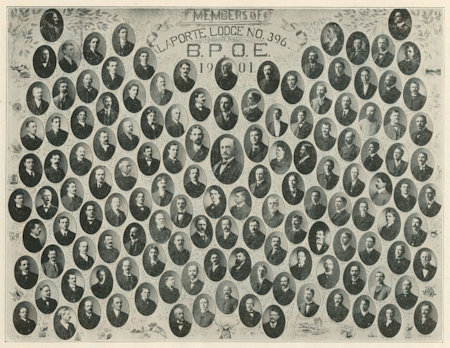
697
in its early growth and in a short time it became a center of trade for the surrounding country. It was incorporated as a town in 1835 and at the close of the year 1836 there were 170 buildings where three years before there were but three.
By 1840 mail service by stage coach was established with South Bend, Michigan City, Plymouth and other important points which had mail connections to more distant cities and towns as well as with the East. In 1852 LaPorte was incorporated as a city with a population of 5,000 and William J. Walker was elected the first mayor. The establishment of the railroad shops in LaPorte proved a valuable industry for a time, bringing skilled mechanics to the city. In 1857 there was a population of 6,000, and while the growth of the city was not rapid it was steady and an improvement in its appearance became noticeable. Streets were improved, sidewalks were built, trees planted until in 1862 it was described by a traveler as an enterprising community with many improved thoroughfares.
The first fire department was organized in 1857 and the equipment was the best to be had at that period. An excellent water works system was built in 1871, which provided for the city’s growth for many years to come and with sufficient power in distributing mains to throw a stream of water over the tallest buildings. The sewerage system was begun in 1872, gas introduced in 1875 and electricity in 1884. Constant improvements have been made in the streets and walks and by comparison with, other municipalities of her size she has been a well governed city and prompt in adopting new ideas of value. LaPorte has adequate transportation facilities, being on the main line of the New York Central, Pere Marquette and L. E. & W. Division of the Nickel Plate System.
It has also excellent interurban electric railway service and an incomparable bus service. The latter system reaches twenty-five towns and cities with a total population of nearly 250,000. It has a full motorized fire department with ample water supply and water mains. There are 400 fire hydrants and five modern fire trucks equipped with all modern apparatus. The water supply is obtained from wells two and one-half miles east of the city limits, pumped through duplicate transmission mains into concrete reservoirs having a capacity of four and one-half million gallons and located at the central pumping plant and then pumped into the distribution mains. The central pumping plant has a capacity of 12,000,000 gallons each twenty-four hours, although the maximum demand is only 3,500,000 gallons per day. Forty to forty-five pounds of pressure is carried for domestic use and 100 pounds for fire purposes. Gas and electricity are furnished at moderate rates.
Health conditions are excellent and when a hospital is required the community has the advantages of a modern well equipped hospital located
698
in the city with skilled practitioners on its staff. The banking facilities are ample to take care of the demands of the community with total deposits of more than $12,000,000 and resources of more than $14,000,000. It is claimed that the per capita wealth is the second highest of any city in Indiana. Liberty Loan Bonds to the amount of one and one-third million dollars were taken by LaPorte citizens during the war—an excellent demonstration of its patriotism and financial strength of its citizens. There are more than thirty diversified industries and more than 100 retail stores. There are eighteen different religious organizations and congregations and seventeen church buildings in the city and the leading religious denominations are all represented.
There are seven public schools and five parochial schools which are maintained at a high standard. An extended story of the LaPorte churches and schools will be found in the chapters on churches and schools. The city has a public library which renders excellent service and is a growing educational factor in the community. It is fully described in the chapter on libraries. First class hotels furnish excellent service at moderate rates. The telephone service is locally owned and there are more than 6,000 telephones in use, or an average of more than one to every four persons in the city. It has an excellent modern three story fireproof Y. M. C. A. building equipped with large gymnasium and running track, hand ball court, swimming pool, shower baths, bowling alley, billiard and pool tables, reading and game rooms. Thirty dormitory rooms accommodate fifty men that are rented at moderate rates. The Y. M. C. A. is active in promoting the social and physical welfare of the boys and young men and is assisting materially in the activities of the nine Boy Scout troops in the city.
LaPorte has never been a boom community but has enjoyed steady, substantial progress, its population at this time approximating more than 20,000. Its beautiful parks, many magnificent residences, attractive unique bungalows, well paved, clean boulevards and avenues lined with large beautiful maple trees, its stately public buildings, splendid playgrounds and conveniences to lake resorts make it a fine home community and an ideal city in which to live. The net taxable valuation of property in LaPorte is $20,251,591 and the total debt is $247,500.
The present city officials are mayor, John Line; city judge, William S. Bliss; city clerk, Albert F. Schultz; controller, Charles E. Zeisig; engineer, Burtis P. Thomas; street commissioner, R. C. Steffenhagen; city stenographer, Owen Line; chief of police, Robert C. Fisher; chief of fire, Thomas Whorwell; board of public safety, Paul Moo, Dallas Zener, Frank C. Foland; board of health, Dr. Charles B. Danruther, Dr. Arthur A. Simon, Dr. Robert F. Wilcox; health officer, Dr. John Pracher; common council, Arthur Baker, Elwood O. Haun, Charles F. Schroeder, Benjamin Borts,
699
Edwin Reinhart, William G. Smith, Charles E. Wolfe; superintendent parks, W. A. Cummings; superintendent water works, Charles C. Fontz.
VALPARAISO.
Valparaiso, originally Portersville, is situated on the crest of the moraine which divides the basin of the Great Lakes from the Valley of the Kankakee. The original site was owned by Benjamin McCarty, who it appears organized a land company to own the property and then offered it to the county commissioners as a site for the county seat. Three other sites for the county seat were considered by the county commissioners but as the McCarty property was the geographical center of the county and appealed to the commissioners from many standpoints and as the land company not only offered the county a desirable site for the court house but ninety-six lots additional and $1,200 in money, the decision was in favor of the Portersville Land Company’s site in preference to Prattville, Flint Lake and another site about one mile and a half northwest of the McCarty property.
Cyrus Spurlock is credited with having erected the first house in Portersville although a house built by C. A. Ballard was just over the line south of the new county seat and the county commissioners held their first two meetings in the Ballard home. Lots were rapidly sold, houses were erected and the little village soon took on a lively appearance. A post office was established with Benjamin McCarthy as the first postmaster. John Herr and Solomon Cheney maintained a tavern—the name of which is not certain—from the early part of 1837 until late in 1838. The American Eagle House was opened as a tavern in 1839. Later David Oakes maintained the hotel, followed by John Dunning and others, including Austin R. Gould.
Elizabeth Harrison opened a tavern in 1845 on the site of the later built Central House. Austin R. Gould, who had been operating the American Eagle House, took charge of the tavern from the Harrison family and operated it for many years after 1855 and his widow maintained it after his death until the building was taken down in 1880. The Central House was erected on the site of the Gould House and it became one of the best known hotels in Northern Indiana. After the Civil war, the Winchell House was opened in the Excelsior Block and after 1875 became known as the Merchant’s Hotel. Slowly but surely the population increased and, although the surrounding country was thinly settled, the business houses generally thrived and many permanent stores were established. The village had the usual line of small manufacturing establishments common in the pioneer settlements and a number of brick yards were in operation.
700
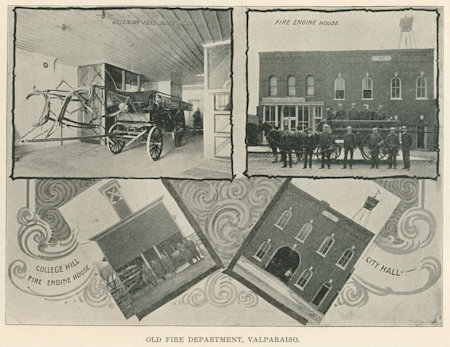
701
In 1866 the Valparaiso Woolen Manufacturing Company began business with a capital of $60,000 which was a large amount at that period. Unfortunately there was a general business decline and a lowering of prices in the few years following the organization and operation of the plant which, with other causes, made the business unprofitable and George, William and Julia A. Powell, who were among the original stockholders, became the possessors of the property. For three years prior to 1875 the plant was used for the manufacture of pins as well as shoddy, but in 1876 the establishment was started on a permanent foundation with the manufacture of Germantown yarns to which the knitting of hosiery was added a few years later. The business was conducted successfully for many years when it was discontinued and the property passed into the hands of the Chicago Mica Company, whose products are now sold all over the world. The Valparaiso paper mill was built in 1867 with a capital of $20,000 and was continued for a number of years and then discontinued.
Additions had been constantly made to the area of the original village and in 1850 it had greatly increased in size with a population of 520. Valparaiso was incorporated as a village by special act of the Legislature in 1850. The town council consisted of six persons and the members were elected annually. Telegraph and telephone service was early established and when Valparaiso became a city in 1865 it was in a flourishing condition and with a population of about 2,300. The first city officials were Thomas J. Merrifield, mayor; John B. Marshall, clerk; James B. Hawkins, treasurer; Isaac Bowman, assessor; A. H. Goodwin, marshal, and J. M. Felton, engineer. The first city councilmen elected were Dr. George Porter, T. J. Hogan, J. C. Pierce, Obdiah Dunham, A. W. Kellogg and A. H. Somers.
The first waterworks was established in 1866 and by complying with certain conditions laid down in the franchise the city had the right to purchase the water company by appraisements at the expiration of the franchise. The system had been unable to meet the demands of the city and the company made no effort to give adequate service. At the time the franchise was about to expire the debt of the city was up to the constitutional limit and there seemed no available way to take advantage of the opportunity on the part of the city to acquire the system by purchase. H. Loring, afterwards judge of the Porter County Circuit Court, was at this time appointed city attorney and immediately gave his attention to settling the existing controversy with the Valparaiso City Water Company. It was clear the city had the right to purchase but no money to purchase with and no bonding power available at the time. The court on an appeal by the city to set a value on the system fixed the amount at $86,000, which the city should pay.
702
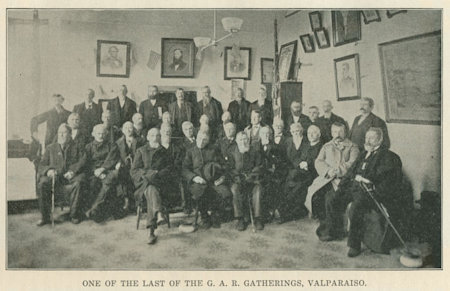
703
Mr. Loring contended that the city could sell and assign its option to purchase and operate the plant to a friendly corporation of its own formation and the corporation thus formed could perform the judgment and operate the plant economically and pay the purchase price out of the income in addition to paying maintenance, betterments, replacements and extensions. This contention by Mr. Loring was forcibly contested by the water company and the position taken by Mr. Loring was new and novel to the legal fraternity of Indiana. Suits were instituted and carried to the Supreme Court for a decision and on June 25, 1893, the controverted question was decided in favor of the city, thus adopting an entirely new rule on law in such cases and which has been generally adopted by other states when brought into controversy. This ruling enabled the city of Valparaiso to form a company and operate the system for twenty-three years when it was turned over to the city (being valued at that time at $250,000), without paying in domestic rates or hydrant rental a higher rate than other cities of the same class while the purchase bonds were being retired.
A gas company was organized in 1879 and shortly thereafter the city was supplied with gas. About 1886 agitation began for the lighting of the city by electricity but it was not until 1894 that a franchise was granted to establish an electric lighting plant, which was given to Edwin S. Tice of Chicago, who in turn sold the franchise to Elzer C. Noe. Later Charles H. Sweet bought the franchise, erected the plant and later purchased the gas company and consolidated the two companies under the name of the Valparaiso Lighting Company. The growth of Valparaiso while steady has been slow, due largely to the fact that it has not become a great industrial center, but the wonderful industrial growth of the lake shore must eventually be felt in Valparaiso and that the available sites on the Porter County shore line of the lake will become throbbing with life and activity seems certain in the near future. It has always, however, been noted for its neat attractive homes with well kept lawns, broad main thoroughfares and shady residential streets lined with beautiful trees.
Its healthful location, its cleanliness and the beautiful lakes nearby are other attractive factors which make Valparaiso an ideal residential city. The city is noted for its high standard of morality as shown by the absence of serious crimes and what few arrests are made are generally for the most ordinary misdemeanors. But two first degree murder cases have been tried in Porter County court in nearly a century and both of these cases were transferred from other counties to Porter County for trial. The general prosperity of the inhabitants is shown in the large amount of deposits in the various banking institutions and owned by a wide number of depositors, and also its postoffice receipts in 1926, which were $98,826, a large amount by comparison with other cities when the
704
population and industries are considered. In 1905 a plan of general street improvement began, with the result that Valparaiso now has thirty miles of improved streets and nine miles additional paved with brick. Nearly all the principal thoroughfares in Valparaiso are now paved and the policy of advanced street and sidewalk improvement is now a permanent policy.
It has become an important center of travel as three national highways — Lincoln Highway, Liberty Way and the Yellowstone Trail traverse the city. The streets are well lighted and there is a modern boulevard lighting system extending for one mile east and west through the city. There are nearly 2,000 dwellings and twelve apartment buildings and seventy-five percent of the dwellings are owned by the residents. The city has a modern motorized fire department with two Seagrave pumpers and 162 fire hydrants combined with ample water pressure and an excellent department personnel. The railroad transportation facilities are excellent, Valparaiso being located on three trunk line railroads, Pennsylvania, Grand Trunk and Nickle Plate. It has interurban electric service with Gary and bus lines operate to Michigan City, LaPorte, Hebron, Kouts, Wheatfield and Chesterton. There are four theatres with a total seating capacity of more than 3,000 and approximately 115 retail establishments, including two department stores.
It has an excellent system of public schools and is the home of Valparaiso University, the history of which will be found in the chapter on schools. It has a population of more than 10,000 — all white — and less than one per cent of the population is foreign. The city has two live daily newspapers and a new seventy-five room hotel costing $300,000. The tax valuation of the City of Valparaiso is $7,156,650, and the bonded indebtedness is only $35,500. The present city officials are mayor, W. F. Spooner; clerk, Flora Kinney; engineer, A. R. Putnam; treasurer, A. J. Fehrman (city and county) ; chief of police, W. Pennington; police matron, Bertha Ewing; aldermen, C. A. Stanton, Charles Hicks, Louis Leetz, Louis Gast, J. R. Palmer, E. S. Miller; street commissioner, Jake Edlemen.
EAST CHICAGO — INDIANA HARBOR.
The creation of Gary as a steel center on Lake Michigan heralded the advent of a great industrial empire, and it was generally accepted as a nucleus around which the future great industrial expansion would be built. However, properly speaking, Gary was merely the extension in this, district of an idea that had been translated into reality a number of years before, and those who conceived the creation of East Chicago and Indiana Harbor had the same vision of industrial supremacy. It is noteworthy that their initial industrial efforts were founded on the creation of metal products.
705
The northwestern section of Indiana was largely swamp land, and the title of much of this rested with the national government. A great deal of the government holdings was turned over to the state by special enactment to be disposed of for school fund purposes. The first acquisition of the land which is embraced in what is now East Chicago and Indiana Harbor was by George W. Clarke, who purchased at a nominal sum about six thousand acres which he turned over to English and Scotch syndicates, among which were a number of well-known British financiers. One of these, the Earl of Leven and Melville, was a moving factor in the acquisition of this property and it was for him that Melville Avenue was named. Other British syndicates which later became investors in the same property were the Scottish-American Investment Company, Ltd., the Realization and Debenture Corporation of Scotland, and the London-Scottish-American Trust. Representing this group of foreign capitalists was the well-known banking firm of J. Kennedy-Todd & Company of New York, who later took an active interest in the development of this region. It was for the senior member of this firm that Kennedy Avenue was named.
At the time the property was acquired there were several elements that entered into its purchase, and its proximity to Chicago with available railroad trackage assured the investors that there was a great possibility of extending the then already growing industrial life of Chicago across the border into Indiana. The idea found favor with many men prominent in the industrial and railroad world, and among these was Gen. Joseph Torrence, widely known as a successful promoter and as a builder of railroads. He had carried Riverdale in the southern end of Chicago to a successful conclusion and about 1887 decided to exploit the land purchase then held by the foreign syndicates.
Entering into an agreement he formed the Calumet Canal and Improvement Company and the Standard Steel and Iron Company, both of which at that time were essentially land companies, although the name of the latter indicated that General Torrence had visions of a great steel and iron center in that community. It was in the name of the latter company, the Standard Steel and Iron Company, that East Chicago was subdivided and it was this company that served as the selling agent for most of the land sold in that early period. In order to have a more cohesive and descriptive organization, he subsequently formed the East Chicago Improvement Company, which absorbed the two aforesaid sales companies and continued their operations under that name. However, dissension arose between Torrence and the English syndicates, who were dissatisfied with his management, and about this time they instructed their fiscal agents of New York, J. Kennedy-Todd Company, to straighten the matter out and if possible to eliminate Torrence from the situation. Accordingly Mr. Todd came to look over the situation and shortly thereafter on behalf
706
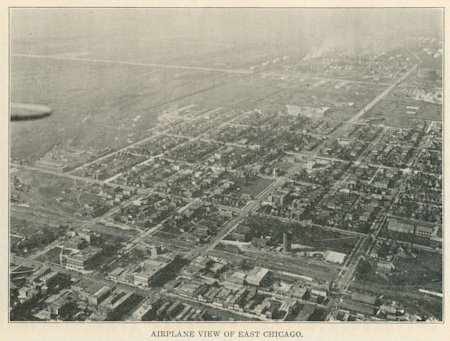
707
of his clients purchased the Torrence interests and he assumed the presidency of the East Chicago Improvement Company in 1892.
There was but a sporadic success in the sale of the holdings at that time as the entire project was looked on as a speculative venture, if not a mere means of exploitation. However, the activity in the region aroused interest in Chicago in the region in general and about 1896 a well-known financier of that city, Owen F. Aldas, organized a group of Chicago investors and purchased the land which formed the site of Indiana Harbor. Their company was called the Lake Michigan Land Company, and it was this company that first subdivided and promoted Indiana Harbor, which was acclaimed as the future industrial town site. This more or less visionary idea was translated into a great semblance of actuality when in 1901 the Block Brothers decided to locate their steel concern in that place and it was this concern which later became the Inland Steel Company and assured Indiana Harbor of its industrial status.
The Lake Michigan Land Company brought a number of live factors into their organization and among these was Albert DeWolfe Erskin, who, under the immediate direction of Owen F. Aldis, took charge of the sale of the Indiana Harbor property. It was evident at that time that due to the proximity of East Chicago and Indiana Harbor there must be a community of interest, and insofar as their aims were in common it soon became apparent that a cohesive organization embracing both factors would be desirable. Accordingly, in 1903, Mr. Erskine organized the East Chicago Company, and the Standard Steel Company and Lake Michigan Land Company were merged with this. The venture had by this time become more than a mere guess and much of the speculative element had been eliminated by the positive accomplishments, so on the formation of the East Chicago Company it was comparatively simple to secure the much additional capital that was needed for proper expansion.
Among the Chicago factors who invested in the East Chicago Company at that time were Mrs. Potter Palmer, Honore Palmer, Potter Palmer, Jr., and Adrian C. Honore, a brother of Mrs. Potter Palmer. Other outstanding investors were Owen F. Aldis, Stanley McCormick, Anita McCormick Blaine, Harold F. McCormick, Delavan Smith, the Baring family, the British and Scotch syndicates aforementioned, Hollabird and Roche, the well-known architects, Jervis Hunt, J. B. Farwell, Jr., Bryan Lathrop. There was a constant though slow infiltration of settlers in the region, and soon residences began to spring up which gave assurance to those who were striving for the securing of industries. Efforts were bent to secure a number of representative industries for the region, and as the Inland Steel Company had attained substantial headway as the successors of the Block concern, it established the status of the new venture as an industrial possibility. Soon the Standard Forging Company was acquired and
708
shortly thereafter the American Steel Foundry. The first factory of consequence secured by East Chicago proper was the Graver Corporation, whose products now are known internationally, and this initial beginning marked the rise of East Chicago as an industrial center.
The first officers of the East Chicago Company were Albert DeWolfe Erskine, president; and George W. Lewis, secretary. In 1904 Mr. Erskine left the company and Honore Palmer was selected to succeed him and the latter directed the affairs of that company until 1906, when C. W. Hotchkiss, the well-known engineer, was chosen as his successor. Prior to his selection as president, Mr. Hotchkiss had served as vice president of the East Chicago Company and before this had been engineer for the Lake Michigan Land Company. His interest in the venture was solicited by other investors who were prominently identified in railroad circles. Mr. Hotchkiss had already attained distinction throughout the country as an engineer, and for a number of years he had achieved big things in engineering for the New York Central Railroad. The growing industries in East Chicago and Indiana Harbor and the possibilities of greater industrial expansion created a necessity for better shipping facilities. To him, perhaps, is solely due the credit for conceiving and carrying to conclusion the construction of the Indiana Harbor Belt Railroad. At the time he proposed it there was a grave question as to its advisability for many reasons. There was comparatively but a few industries in the region and while there was a natural expectation of greater growth it was conceded by even the most optimistic that this would be the gradual growth of many years. To suit problems of that time it was regarded as fully sufficient by most of the interested persons to have additional trackage to the terminals in Chicago, and Mr. Hotchkiss’ proposal of the creation of a belt railroad was generally regarded — at its best — as a bold anticipation of future expansion without any positive assurance that this expansion would be attained. However, the argument and reasoning of Hotchkiss that the creation of such a belt railroad would in itself attract many industries won the day, and after proper financial support had been assured by the New York Central Railroad he carried the thing to a successful conclusion; this, probably more than any other element, is responsible for the early development of the industrial life there. It affords the same facilities for shipping as are enjoyed by Chicago’s industries, and allowing as it did minimum charges in freight transportation — outgoing and incoming — it was a very positive contribution to the financial success of the early industries.
Before Mr. Hotchkiss became president, C. A. Westberg had directed the affairs of the East Chicago Company for many years. On the retirement of Mr. Hotchkiss from the presidency of that company Mr. Todd succeeded him, and C. A. Westberg was selected as treasurer in 1906. He
709
had previously served as manager and was elected vice president in 1909. Soon thereafter Mr. Todd retired from the active direction of the business, and since that time Mr. Westberg has continuously directed the affairs of that company.
During the Hotchkiss administration of the East Chicago Company affairs, a new factor came into the community in the person of Walter J. Riley as a salesman. Mr. Riley at that time was a youth with ambition and vigor as his two great assets. Like Westberg and others of the younger element of that period Mr. Riley had sublime faith in the future of the region and held on working diligently even though the returns were somewhat small. On the retirement of Mr. Hotchkiss from the presidency of the East Chicago Company he organized the First Calumet Trust and Savings Bank, and Mr. Riley was selected by Hotchkiss as vice president of that institution. A warm friendship grew up between the two men which ripened into an affection as between father and son. On the death of Mr. Hotchkiss, Mr. Riley very properly succeeded him in the many avenues that claimed Mr. Hotchkiss’ attention, and the ascendency of Riley to a position of constructive influence in this region and as a powerful financial force is known to all.
EAST CHICAGO.
INCOPORATED AS A TOWN — The first permanent resident family is said to have been the Penman family in 1888 and with the promise of activity and growth there were 1,000 residents by 1890, and the town was incorporated. Ten years later, in 1900, the population was 3,000 and a few years later a city form of government was established as the growth of population steadily increased. The great minds of the able men who were directing the destinies of East Chicago at this period and who saw their long cherished dreams of a great center of industry likely of fulfillment now turned their thoughts from the promotion of industry to laying the foundation for the development of a great city. As they so well planned for its industrial growth so they now peered into the future to determine the needs of a large population. Streets and thoroughfares, proper lighting facilities, sewers, an abundant water supply, a library and schools were planned and established and so well did they master the various problems that the needs of the population have been largely met and provided for nearly on a par with the phenomenal growth of industry.
It is only when one compares the marshes, underbrush and sand ridges of 1900 and the small community and its little municipal conveniences, with the splendid development of today, that the efforts of the earlier citizens and the foundation they laid are awarded proper recognition. Handicapped by unfavorable natural conditions, they nevertheless have
710
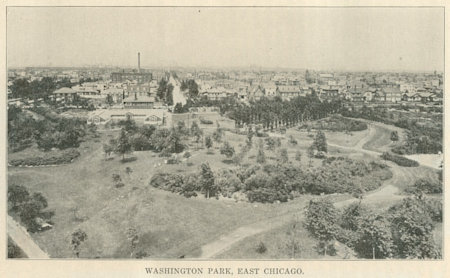
711
built a city with many modern conveniences and engineering genius is now at work to supply the missing links found in the most modern types of municipalities. With its large and steadily increasing population and wealth and therefore in a position to assume and carry forward great projects in civic improvements, the plans for which are now in contemplation, and with the unified cooperation of the leading citizens who have made history through their accomplishments in business and industry, East Chicago may be said to be on the threshold of great civic development.
PREPARING FOR THE FUTURE — The city survey, which has been conducted by the East Chicago Chamber of Commerce and which covered all the principal civic needs of the city, has been completed, and as a result of the investigation plans are being formulated to carry into effect the best methods to improve the housing conditions, lessen street congestion by means of widened, straightened and extended thoroughfares, and eliminating grade crossings. Features of the report covering zoning, taxation, playgrounds and parks, schools, religious activities and nearly every phase of community life are now being considered by committees of the Chamber of Commerce and progressive recommendations and results will follow.
Among the most important recommendations in connection with the city survey were those relating to the number and type of new dwellings that are needed and which will have an important influence on the future of the city as thousands of employees in the East Chicago industries are obliged to live in surrounding cities through lack of housing accommodations. This matter is not being overlooked by some of the industries in East Chicago and great credit is due the Mark Manufacturing Company for the splendid example of industrial housing developed some years ago by that corporation which is now a part of the Youngstown Sheet and Tube Company and it is said the latter corporation now have under consideration several plans for providing housing facilities for the many new employees who will be brought to the city when the extensive construction plans of the company are completed.
On a part of a 190 acre tract reclaimed from a waste of sand and swamp the Mark Manufacturing Company erected well built stucco houses on asphalt streets. The staggered arrangement of the houses affords an outlook from each house and a privacy for each tenant that bears testimony to the skill and understanding of the Chicago architect, Howard Shaw, who conceived and carried out the plan. The houses are two story structures with basements and they all have modern conveniences. There are 103 buildings of the detached, semi-detached and group type having from four to seven rooms each. They are rented to the employees of the Youngstown Sheet and Tube Company exclusively at such attractive prices that there is always a waiting line. Facilities for recreation are provided
712
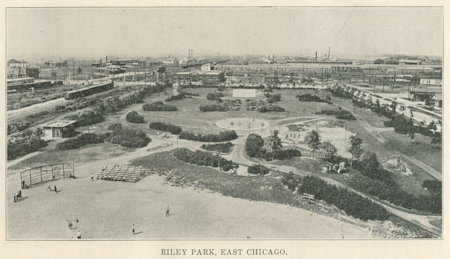
713
by playgrounds for the children and tennis courts, baseball and football grounds for the adults.
For some years beautification of the city has been a subject of general study and thought by the citizens and plans in this direction are moving steadily forward. An excellent start has already been made with East Chicago’s beautiful parks and a tree planting program will be inaugurated in the spring of 1927, when trees best adapted to East Chicago’s sandy soil and industrial conditions, will be planted on all thoroughfares and splendid cooperation in beautifying home surroundings in the residential district is promised by the owners and the vision of green lawns, flowers, shrubbery and tree lined streets which has existed a long time in the minds of many people will become a reality.
East Chicago has only an area of ten miles with its greatest east and west length two and one-half miles, but its nearness to Chicago causes it to have a total railroad mileage of approximately 200 miles, which include all trackage of steam and electric lines. There are sixty-three miles of first main track and about 140 miles of third and fourth main and side tracks. Ten steam and electric roads operate in this city. The trunk lines which traverse the City of East Chicago are the Baltimore & Ohio, New York Central and the Pennsylvania, while leased tracks carry the trains of the Wabash and Pere Marquette. Of the belt lines there are the Baltimore & Ohio Chicago Terminal, the Chicago, Lake Shore and Eastern, which is operated by the Elgin, Joliet and Eastern, the South Chicago and Southern, the Elgin, Joliet and Eastern and the Indiana Harbor Belt Railway.
The electric lines include the Hammond, Whiting and East Chicago Street Railway, which links those cities with Chicago, the Gary Street Railway, also an intercity line, and the Chicago, South Shore and South Bend Railway, which operates between Northern Indiana cities. While the through passenger, the Chicago suburban and the city and intercity passenger traffic is extraordinary it becomes insignificant when compared with the movement of the vast amount of freight in the city. The more than forty industries daily receive and ship hundreds of cars of freight which includes coal for the coke ovens and steel mills, while the shipments include the products from the oil refineries and the finished steel products from the various industrial plants. This tremendous movement of freight explains in part the large amount of trackage in the city.
Every effort is being made to improve the local transportation facilities and care for the constantly shifting travel in a growing city so that comprehensive and efficient service may be provided for years to come. East Chicago now has about seventy-five miles of platted streets within its corporate limits, laid out in a rectangular system, characteristic of American cities. When the improvement plans are completed the Ea:t Chicago
714
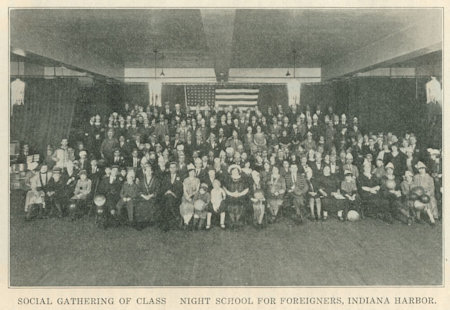
715
street system will be a model for other cities. The great tide of automobile travel to and from Chicago east and west brings to the city thousands of tourists, and because of the Dunes Highway three-fourths of the regular automobile shore travel is through the city.
The Dunes Highway, which is more fully described in the chapter on transportation, is the chief motor route for traffic on the Lake Michigan southern shore, and it is said that 50,000 or more machines, carrying 200,000 people, pass through the City of East Chicago over the Dunes Highway on any of our national holidays. In addition it has become the principal route of travel for motor trucks that ply between the great steel plants and oil refineries of the Calumet District and the automobile freight lines between East Chicago and the Eastern cities. This tremendous amount of traffic is being successfully cared for in the city through an excellent system of policing and traffic regulations, and with the widening of the main thoroughfares in the near future, the problem of caring for the continued growth of this traffic will be solved.
One of the problems which East Chicago must solve, in connection with Hammond and Whiting, is a new method of sanitation and sewage disposal, which is being given proper consideration and will be solved in the near future, probably through a central disposal plant. The solution will prevent further contamination of the waters of Lake Michigan by waste from municipalities and industrial plants.
PARKS AND RECREATIONAL CENTERS — Realizing the great advantages resulting through making proper provisions for centers of health and recreation, East Chicago has been generous in the past few years in this respect. Great thought has been given to the health of the present and future inhabitants of the city and East Chicago will be soon such a pleasant place in which to live that as soon as the housing conditions are corrected, the employes of the industrial plants will have no reasons to live other than in the city where they are employed. Washington Park, situated on a former waste of sand, and Riley Park, with playgrounds, in the heart of East Chicago’s industrial center, are but the beginning of a series of beauty and pleasure areas to be located in available territory. The city already controls approximately 1,500 feet of beach frontage, and when the improvement of this area is completed it will be a great center of beauty and recreation.
The new municipal swimming pool at Tod Park, completed July 1, 1925, at a cost of approximately $50,000, is another example of the thought being given to the care and health of the inhabitants. The pool has continued to grow in popularity since it was built and affords clean and wholesome recreation. It is rectangular in shape and measures 150 feet long by 50 feet wide, with a depth varying from 18 inches to 81/2 feet, and a
716
capacity of 275,000 gallons. Through the Western Union and Postal Telegraph companies East Chicago enjoys telegraph service to all parts of the world, and has excellent telephone service through the Illinois Bell Telephone Company. There are now about 4,500 telephones in service. The story of the religious life of the city and the excellent school system which East Chicago now has and the great financial strength of its banking institutions and the leaders in the financial life of the city are comprehensively recorded in the respective chapters on churches, schools and banking.
The city hall is located in the East Chicago section and was erected in 1908 at a cost of $65,000. Adjoining the city hall site is the fire department headquarters in a building which cost $20,000. A new municipal building was erected in Indiana Harbor in 1908, at a cost of $28,000, to house the police department and the Indiana Harbor branch of the fire department. The fire department has the most modern equipment and most of the industrial plants have their own special fire protection. The police department is an exceptionally well conducted institution and Chief James W. Regan is becoming widely known as a great police department executive. Due to Mayor Hale’s policy of keeping the police department divorced from politics, the department is in an excellent state of efficiency from every standpoint. As a result of Chief Regan’s training and experience, the most modern methods in the conduct of police departments and the apprehension of criminals have been introduced. East Chicago is a particularly difficult city to police on account of the language difficulties associated with a large foreign population, but since Chief Regan has been in charge of the department the mystery attached to nearly every major crime has been solved and the criminals apprehended.
The present city officials are Dr. Raleigh P. Hale, mayor; city judge, Michael Havran; city clerk, Paul Halstead; city treasurer, Andrew Rooney. The members of the city council are Richard Davis, John T. Breclaw, George Jordan, Joseph Huwig, John Fusek, George Stoddard, John Tenkely, Robert Smith, Stanley Raczkowski, Louis Ferrini. East Chicago is fortunate in having at the present time an excellent city administration, not only the mayor but the members of the city council being registered among the forward progressive citizens in the city, and their acts already indicate they will make every reasonable provision for the needs of the growing population. Raleigh P. Hale, mayor, is a doctor by profession and a citizen of broad vision, and favorable to the adoption of measures which will add to the comfort and conveniences of the inhabitants.
East Chicago’s charities and social welfare work is supported through the Community Chest Association, and East Chicago is distinguished in having more contributors to its Community Chest than any other city
717
in the country with nearly the same population. The officers of the Community Chest arc Judge M. E. Crites, president; H. W. Peterson and J. J. Block, vice presidents; Julius S. Friedman, treasurer; Edith Collier, secretary; and H. R. Packard, manager. Judge Crites, the president of the association, has been for years one of the leading citizens of East Chicago and has a sincere interest in social welfare movements. He has been president of the association since it has been organized. The building permits in East Chicago and the Indiana Harbor section largely for residential and business buildings totaled $4,139,902. Included in this amount is approximately $200,000 expended for buildings on the East Chicago portion of the Roxana Petroleum Company’s refinery site. During the year the Alder Street pumping station was completed at a cost of $300,000. The assessed valuation of East Chicago is $79,597,615.
WHITING.
Today Whiting is known as a refinery city, as the seat of the Standard Oil property embracing row on row of tanks, the terminal of pipe lines from distant oil fields, and the place where these crude oils are refined into gasoline and all of the collateral products that oil furnishes. However, Whiting was not originated as an oil center, for at the time of the advent of the oil industries into Whiting there was then living there more than fifty families, mostly sturdy German settlers. The swamps and the sloughs then isolated them from the rest of the community; the pioneers often walked nine miles to Tolleston to pick berries, and it was the custom then to walk to Hessville to vote—a round trip of twenty-five miles. The schoolhouse in the little settlement was used for church services, and in the main the settlers lived a satisfied and contented pastoral life. There was at first resentment at the intrusion of the industries on the peaceful isolation of the little hamlet. This intrusion upset conditions; newcomers by thousands came; German gardens were purchased, uprooted, and platted; shrubbery and flowers disappeared before the ruthlessness of progress; the hiatus of gardens, hunting, and fishing, and an evening pipe with neighbors was dissolved and digested by the new ferment of activity; old homes—sacred homes—were razed to give way to new buildings, and a number of the pioneer abodes gave way to the erection of the new refinery. Thus passed into history the pioneer days of Whiting.
The first of the early settlers to arrive on the site of what became Whiting came there about 1852. Due to the industrial changes the descendants of the early families have become widely scattered although many are still living in Whiting and vicinity. Among the Whiting pioneers were John Steiber, Carl Steiber, Christopher Harms, Herman and
718
Conrad Weusenfeld, Henry Reese, John F. K. Vater, Henry Eggers, Christopher Schrage, John Kreuter, Robert Klose, Wilhelm Horlbeck, Albert Poppen and Robert Atchison. Many settlers had homes on lands bordering on Berry Lake among them were the Fischers, Ehlers, Wenzels, Ewidendorfs and other families who were among the very oldest settlers. A famous hunter in the sixties and seventies was Edward Slater who also had a home near Berry Lake. Additional names of pioneer settlers are Davis, Wonnacott, Fred Opperman, Gehrke, Scholz, Harvey Fischrupp, Falkenthal, Mettier and Beneke.
When the location of the oil plant was selected the tract was crossed by three trunk lines and one belt line: the L. S. & M. S., B. & O., Pitts-
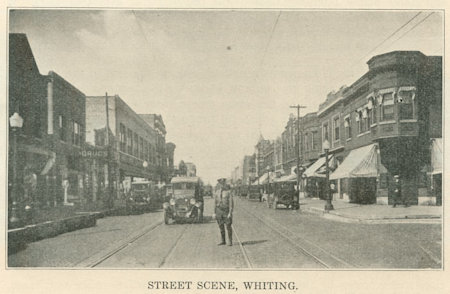
burgh-Fort Wayne-Chicago, and the Chicago Terminal Transfer. To these have been added the belt lines, Elgin, Joliet & Eastern, and the Indiana Harbor Belt Railroad. The early wagon roads were merely tracks in the sand; one of these, now called One Hundred Nineteenth Street, leading west connected with other tracks in the sand and finally became recognized sand track highways to Chicago and other places. Over these tracks passed many emigrants’ wagon trains, some going to Fort Dearborn and others farther west.
The tract of land secured by the Standard Oil Company is about three miles long and one mile wide, and is almost an island. It lies on a beautiful curve of Lake Michigan’s shore, two miles east of the state line between
719
Indiana and Illinois. Along the northern side of this tract for a distance of three miles are the blue waters of Lake Michigan; on the west Wolf River leads south from Lake Michigan to Wolf Lake; on the south are the shallow lakes, George and Berry, leaving only a narrow stretch of sand connecting this country with the land lying east of it. The reason for the selection of this site is as follows: The great Lima oil field of Lima, Ohio, was the largest Western field and one of the greatest fields of the country. Its proximity to Chicago made it the natural center of supply for Chicago industries. However, as Lima oil was strongly charged with sulphur, it was necessary to evolve a process of eliminating this sulphur to make it industrially useful. Behind barricaded doors chemists worked on the problem, and in the early ‘80s solved it. Meanwhile Lima oil had been piling up in storage tanks, and a pipe line was constructed from Lima to Chicago, the west terminal being at the foot of One Hundredth Street, on the lake. This station was called Fleming Park and is now a part of the Calumet Park in Chicago. At this time agitation arose against the proposed refinery there due to pungent odors of Lima crude oil. About this time one of the tanks split from top to bottom, pouring oil over the ground; this settled the question—the citizens there did not want oil as a next door neighbor.
LOCATION AT WHITING.
About February, 1889, came the first disclosures that Standard Oil Company had agreed on Whiting as the place for future operations. At that time William Irish of Olean, New York; James A. Moffett of Brooklyn, and W. P. Cowan, superintendent of the Standard Oil Company of Cleveland, called on William Curtis, then master mechanic of the Cleveland refinery, and showed pencil sketches of the proposed plant and site. From that time until his retirement thirty years later Mr. Curtis was an active factor of the Whiting plant. Meanwhile the purchase of land had been going on; representatives of the company, accompanied by Henry Schrage, the postmaster of Whiting then, visited the owners of the different little farms buying acreage. The land purchased included the little village of Oklahoma, and the hundred houses that constituted this little town were removed to Whiting. Following this was a succession of improvements—sewers, sidewalks, waterworks, and eventually the storage tanks and refinery.
ORIGINAL LAND OWNERS.
The foundation of Whiting, like East Chicago, begins with the story of George W. Clark, George M. Roberts, Jacob Forsythe and Henry Schrage and their purchase of large tracts of swamp land in the northwestern
720
part of the Calumet Region. Beginning with 1850, George W. Clark began to acquire thousands of acres in this territory, and shortly afterwards George M. Roberts secured some large tracts, and between these two owners the northern and central part of North Township was largely under their control. Mr. Clark died in 1866, and a large part of his holdings was transferred to an English syndicate, the remainder being retained by his sister, whose husband, Jacob Forsythe, was a conspicuous figure in the early development of this section. After the Civil war Henry Schrage, a young German American soldier who had honorably served his adopted country during the internal strife between the states, came to the territory and secured employment on a railroad. He had a keen business instinct and, believing there was a good opportunity, he opened a general business store in the little settlement which afterwards became the City of Whiting. With that foresight for which he and his sons became later famous, Mr. Schrage put nearly all of his profits into real estate in and around the settlement, and thus when the Standard Oil Company decided to locate there, Mr. Schrage had the property they desired, which was sold to them, and the foundation of the City of Whiting was laid with the establishment of the Standard Oil Company.
ATTEMPTS AT INCORPORATION.
The first efforts to incorporate Whiting as a town were made in the spring of 1892. An informal meeting was held at Soltwedel’s Hall. A preliminary organization was made and Dr. W. E. Putnam was selected as chairman, and U. G. Schwartz as secretary. Much argument was used against the proposed incorporation because of possible increased taxation; however, momentous questions are sometimes settled by tragic events, and a sinister quip of fate ushered Whiting into the status of a town through the portals of grim tragedy. On the evening of July 17, 1893, a group of seven wandering strangers came to Hunter’s Resort, operated by William Timm, in Robertsdale, situated in a sparsely settled place between the Pennsylvania and the L. S. & M. S. tracks. The strangers made a murderous assault on Timm, and when the fray ended two of the strangers were dead, another died weeks later in a hospital from injuries received there, and Mr. Timm and George Dorsch, his friend, were severely wounded. This incident demonstrated the need of municipal protection; Robertsdale was seized with fear, and petitioned Hammond to annex it, which shortly afterward was effected.
There was some opposition in Hammond against extending the boundaries, but as Hammond had a pumping station in Robertsdale, there was some logic in absorbing that site. With the change in the city administration of Hammond there was a change in the annexation question because
721
the new officials saw a chance to lighten the Hammond tax burdens and they accordingly passed an ordinance not only annexing Robertsdale, but also the territory of Whiting, exclusive of the cottages and plant of the Standard Oil Company. Following this Hammond policemen were patrolling Whiting and then and there ensued a feud between the “furriners” and the home folk. The Standard Oil Company and the citizens of Whiting began a legal battle against the invaders that lasted for two years. In May, 1894, the Whiting Democrat was founded by U. G. Schwartz, and his caustic editorial tirades against Hammond effrontery roused Whiting to a pitch of militant determination. Every meeting of the Hammond Council found Whiting citizenry declaiming against the outrage.
The dissolution started in June, 1894, at which time a petition for the incorporation of Whiting was filed with the county commissioners. The petition was granted June 10, and June 27 was the date set for holding the election. The Hammond Council, however, took an appeal, and this came up in the Lake County court February 6, 1895. The decision rendered in March, 1895, favored Whiting, and in the following session of the commissioners, June 3, an order was issued for Whiting to hold an election, and the election was set for June 18, 1895. Henry Schrage, U. G. Schwartz, and C. V. Crane were appointed inspectors; the result was 685 for, and 2 against, the proposal. On June 25, 1895, Hammond policemen were withdrawn.
At the next session of the county commissioners, September 3, the first business taken up was the order for the election of officers. A mass meeting was held in Mettler’s Hall on September 18, at which Fred P. Allen presided, and a babble of voices nominated favorite candidates. Out of this medley were chosen rival tickets, and on election day, September 30, the citizens’ nonpartisan ticket was nominated—viz., councilmen: W. S. Rheem, Henry Schrage, F. J. Smith, George W. Humphrey, Fred Fischrupp, William Emmel, and P. A. Hickey. However, this election was nullified, as Hammond had filed an appeal a few days previously, but the fight was ended abruptly when E. D. Crumpacker, candidate for the nomination for Congress against Frank Hanley, found that he was in dire need of the Whiting delegates, as the vote narrowed down to a possible majority of but two votes. The Whiting delegates were instructed to vote against Mr. Crumpacker, who was a brother of Peter Crumpacker, city attorney of Hammond at the time of the annexation fight. The convention was held, and Mr. Crumpacker—sorely in need of Whiting’s votes —effected a compromise by which Whiting was guaranteed that the annexation fight would be dropped by the Hammond Council. This resulted in Mr. Crumpacker’s nomination and subsequent election to Congress. On October 6, 1896, on the motion of Councilman Richard Schaaf of
722
Hammond, the Hammond Council nullified all proceedings to incorporate Whiting as a part of that city.
The withdrawal of the appeal and all court proceedings on the part of Hammond permitted Whiting to succeed as an organized community. At this period Whiting had a population of about 2,400 people, nearly all adults being employed by the Standard Oil Company, and with the growth and development of the Standard Oil interests the population steadily increased. Whiting became a city in 1903, and W. E. Warwick was elected the first mayor, serving for three years. In Mayor Warwick’s administration a system of modern municipal improvements was in-
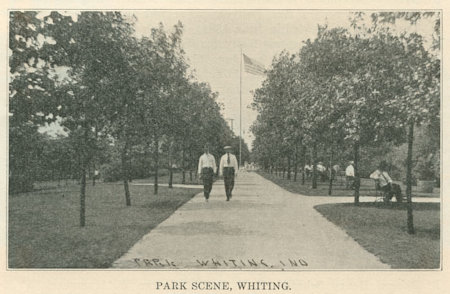
augurated, which was carried forward by each succeeding administration until at the present time Whiting is recognized as a thoroughly modern municipality.
A waterworks system rendering adequate service at moderate rates was early established, and with ample water pressure for fire service and a modern motorized fire department with an efficient personnel have kept fire loss at a minimum. In addition to the city fire department the Standard Oil Company maintain their own system for the protection of their plant. The sewer system is designed to meet the special needs of the city and has proven its efficiency. The policy of permanent surfaced streets and sidewalks, begun under Mayor Warwick’s administration, has been broadened under his successors and is now the established policy of
723
the city. In 1906 agitation for the establishment of a city park led to the purchase two years later, in Mayor Smith’s administration, of twenty-two acres of land from the Forsythe estate for $75,000.
An expenditure of $25,000 for improvements wrought a wonderful change in the property, which had a most favorable location bordering on the lake, and the unsightly area purchased was converted into one of the beauty spots on the lake shore and a center for pleasure and healthful recreation for both young and old. Flowering plants and shrubs everywhere greeted the eye, beautiful walks and parkways were laid, playgrounds with apparatus for children were provided, and a section set aside where pleasures and sports for the mature could be enjoyed. Winter pleasures were provided through large safe skating areas with heated buildings nearby. With the progress of years and through generous financial support by the city, new features were added, including recreation piers, until it may be said the Whiting City Park is one of the most popular year-round recreation spots on the entire lake shore.
The police department have a very efficient personnel and the city has an excellent moral record. Whiting has a healthful location and an active and efficient board of health, who exercise watchful care to prevent the spread of serious diseases and maintain modern laboratory equipment. The maintenance of well lighted streets and thoroughfares has been a standard city policy and the city provides liberally for this purpose, and Whiting is recognized as an exceptionally well lighted city. Its schools are excellent and its library an educational factor of importance, and both are comprehensively treated in the chapters on schools and libraries. Whiting is a city of opportunity and will share generously in the future growth in population and industry destined for the Calumet Region. The present officials are: Mayor, Henry Schrage; city clerk, Harry E. Powers; city controller, R. F. Denham; city treasurer, Edith Langenhan; city judge, T. Joseph Sullivan; aldermen, William Walker, Frank M. Long, John Duffy, Joseph Mauchak, John McTague and William Stoll. The assessed valuation of Whiting is $27,013,080.
HOBART AND CROWN POINT.
The early history of Hobart and Crown Point has been well covered in the pioneer section of this history and the banks, churches, schools and libraries in the chapters devoted to these institutions. Both of these communities are feeling the effect of the wonderful growth of the industrial cities on the North Shore and it seems likely that Hobart at least will in the not distant future lose its identity in a greater Gary. Hobart has an exceedingly healthful location and is sufficiently elevated to have a good natural drainage to Lake Michigan by means of the Deep River
724
and the Calumet. It was incorporated as a town in 1889, and has grown steadily in the past few years. It has excellent lighting and water supply systems, maintains two newspapers, and has been a center of the manufacture of bricks and tile for forty years. The leading national organizations have lodges in Hobart and is an enterprising progressive community. Like Hobart, Crown Point has a healthful location, is a fine residential community, and has excellent railway transportation. It has improved streets, is well lighted, and has an excellent water supply system. With the greater growth of the industries on the North Shore, the health-
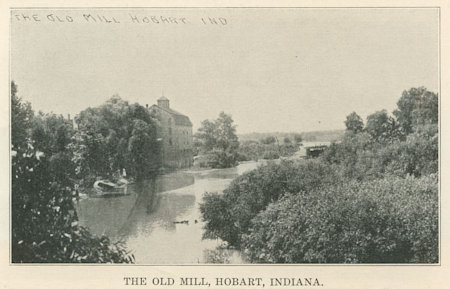
ful location of Crown Point — 132 feet above Lake Michigan on the north and 90 feet above the Kankakee River on the south, and with excellent natural drainage — should appeal to many people in the industrial area as a most desirable place for residence. It has one important manufacturing industry, the Letz Manufacturing Company.
HAMMOND.
The City of Hammond is located in North Township, Lake County, at the southern end of Lake Michigan, and twenty miles southeast of Chicago. On the north and east it is bounded by Whiting, Lake Michigan, Whiting and East Chicago, and its western boundary is the Indiana-Illinois state line. It is from 5 to 30 feet above the level of Lake Michigan, and
725
585 feet above sea level, and at the present time has an area of approximately twenty-seven miles. In 1867 the territory now included in the City of Hammond had but little population, there being two small villages, West Point and Hessville. The establishment of a large lumber yard and sash and blind factory was responsible, it is said, for the addition of nearly 1,500 to the population.
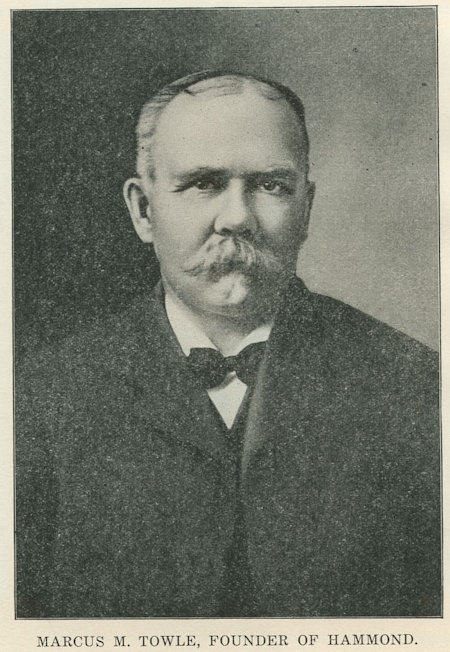
To Marcus M. Towle really belongs the credit of giving Hammond its great start in industry and thereby its prosperity, and his brothers, C. N. Towle, E. E. Towle, A. G. Towle and P. B. Towle, contributed also in some measure to the upbuilding of the pioneer community. It originally was called State Line, but, at the suggestion of M. M. Towle, the postal
726
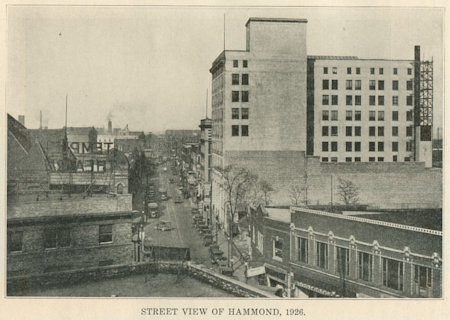
727
authorities changed the name of the postoffice near the Hammond slaughterhouse from State Line to Hammond in 1873. Mr. Towle platted the original town in 1875, but it was not incorporated as a city until 1884, Marcus M. Towle being the first mayor; George H. Boyton, clerk; Charles C. Smith, treasurer; Donald McDonald, city attorney; Allison A. Walker, marshal; and Carol N. Towle, chief of the fire department. The first councilmen elected were Patrick W. Mullins, S. F. Fogg, William H. Gostlin, William Kleihege, Henry W. Sohl, and Michael Clement.
Beginning with the first officials, Hammond has been particularly fortunate in its choice of mayors and other city officials. They have been great administrators, men with broad perspective, and their influence and that of the citizens generally was directed toward making Hammond a modern municipality, and the city has kept pace in its developments with the needs and necessities resulting from its industrial growth. Its present mayor, A. E. Tinkham, is a man of broad vision whose every thought and attention is being directed to the development of Hammond and its interests. Until 1894 the city had but three wards, but in that year the fourth ward was added, and a fifth ward in 1896. A new division of the city into ten wards was made in 19D8, and in later years three additional wards were added, the city now having thirteen wards, with eighteen councilmen, one being elected from each ward and five from the city at large. The offices of mayor, city treasurer, city clerk, and city judge are elective, with service for four years, and all other offices are appointive.
Marcus M. Towle, the first mayor, was born in New Hampshire, learned the butcher trade in Massachusetts, and later moved to Detroit. While there he enjoyed the friendship of George H. Hammond, who owned a small meat store in Detroit and who had conceived the idea of shipping fresh beef to the Eastern markets, instead of shipping cattle on the hoof in stock cars, as was the custom at that period, and Mr. Towle agreed to share in the expense of a test shipment. The Davis Brothers of Detroit had considerable success in shipping fish from Detroit to Eastern markets in a special refrigerator box, and designed a refrigerator car in which to make an initial shipment of fresh beef to determine if the idea was a practical one and the business possible of operation on a large scale with success. The refrigerator car was finished and loaded with fresh beef at Towle’s slaughterhouse in Detroit, arriving in Boston in six days, where, in the presence of shippers, railroad men and others, the car was opened and the beef found in fine condition, notwithstanding the weather had been very warm during the journey.
A partnership was formed, with Mr. Hammond taking one-third interest, Caleb Ives, a Detroit banker, one-third interest, and Marcus M. Towle and George W. Plumer each a one-sixth interest. The original capital invested was said to have been $6,000, and as Chicago was a large
728
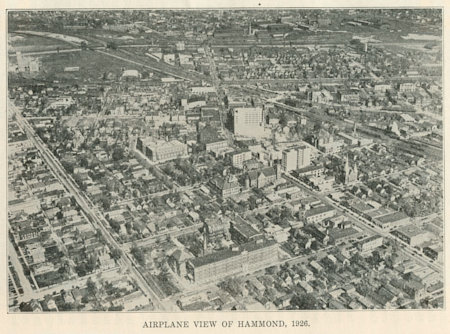
729
market for cattle on the hoof, it was decided to seek a location in Chicago or near there, where an abundance of ice could be had, as well as being near the live cattle market. Various sites were tentatively selected but for various reasons were abandoned. The site finally chosen for the plant was just east of the state line of Indiana-Illinois, with the Grand Calumet River on the north and the Michigan Central Railroad on the south. The tract of land contained forty acres and was purchased from Ernest Hohman and his wife, Caroline, at $100 per acre.
In 1869 the packing establishment began business, with M. M. Towle as resident manager. From a basis of 300 cattle an average per week, the business grew to thousands of head per day, and was extremely profitable to those interested. Five years after the establishment of the plant Mr. Plumer died, and his partners bought his one-sixth interest for $50,000. Confident in the solidity and future of the business, Mr. Towle platted the original town of Hammond in 1875, largely for the purpose of providing homes and homesites for the employes of the plant. He also established a large lumber plant and planing mill and there was soon a lively settlement in the vicinity of the slaughterhouse. For the convenience of the employes and their families he had established in 1869 the first general store in Hammond, near the G. H. Hammond office, where a wide variety of goods were carried and sold at moderate prices.
After the platting of the city, Mr. Towle withdrew from the packing firm and devoted his time to the development of real estate and the introduction of new industries in the vicinity, in many of which he took a financial interest. Among them were the Tuthill Spring Company, the Hammond Buggy Company, the East Chicago Steel Works, the Kingsley Foundry, the Chicago Steel Manufacturing Company, the Chicago Carriage Works, and the Hammond Corn Syrup Works. He also assisted in the promotion of the Chicago & Calumet Terminal Railroad and the Western Indiana Line, and operated the first electric light plant in that territory. He was ably assisted in his industrial efforts by James N. Young, who was an important factor in the development of the region for many years. Mr. Towle also organized the First National Bank of Hammond, and when he died, in September, 1910, he left behind him a record of achievement which fully entitles him to the credit of being called the founder and builder of this great city and an industrial genius of the first magnitude.
It has been mentioned that the forty acres of land purchased by the Hammond Packing Company for its plant was sold by Ernest Hohman, who was a German tailor and came to America from Prussia in 1849. After a short time in Chicago he bought forty acres of land in what is now North Hammond, and having great faith in the future of the territory, he increased his holdings from time to time until he owned nearly a thousand
730
acres on both the north and south banks of the Grand Calumet River. His foresight was rewarded with the growth of Hammond as an industrial center and many of the additions to the original Hammond plat were from the Hohman land holdings in that section. The rise in realty values has made the Hohman estate of great value and the principal business avenue in the city bears the name Hohman Avenue.
After the retirement of Mr. Towle, the Hammond Packing Company business was controlled by George H. Hammond and his brother Thomas, the latter serving as mayor of Hammond from 1888 to 1892, and the following two years as a member of Congress. He was prominent also in real estate and industrial development and was largely instrumental in
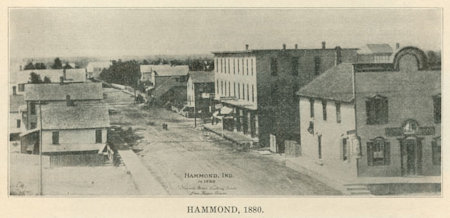
locating some important industries in Hammond, the principal one being the W. B. Conkey Company, who have one of the largest printing and publishing plants in America.
In 1901 Hammond suffered a severe blow through the burning of the Hammond slaughterhouse, and the Hammond Packing Company deciding not to rebuild but transfer the business to the Chicago Stock Yards. At that time, however, other industries which had been located in Hammond and vicinity had given the city a large measure of stability, and the many advantages of the territory for industrial development were becoming generally known, and in the next few years some important manufacturing enterprises were located in Hammond, Whiting and East Chicago and many industrial leaders began to view the district with favor.
731
Beginning with 1905, Hammond grew by leaps and bounds. In 1910 it had a population of 20,925, and in 1920 36,000. Great as this increase in population was in ten years, it was exceeded in the following five years, the population in 1925 being more than 55,000, and now is approximately 60,000. Seventy-seven per cent of the population is of native white stock, and there are about 21 per cent foreign born and 2 per cent Negroes and others. During its phenomenal growth modern thought and effort was directed in providing every municipal convenience and comfort for its inhabitants and proper provision for the development of its industries, as the following statistical story shows. There are over 150 miles of improved streets and a slightly less number of miles of sidewalks, and in addition, it is the Indiana terminal for converging travel from the South and East for Chicago, there being nine marked national or important state highways entering Hammond, including the Ade Way, Dunes Highway, Huntington-Manitou-Culver Trail, Jackson Highway, Liberty Way, Lincoln Way, Michigan-Detroit-Chicago Highway, Chicago-Benton Harbor Trail, and the Yellowstone Trail.
About 100 miles of combined sanitary and storm sewers have been built, including 3 1/4 miles of intercepting sewers, the combined cost being over $4,000,000. Fifteen acres of land on the Grand Calumet River have been secured for a purification plant to be built in the near future. The waterworks are owned and operated by the municipality and are valued at $2,000,000. The sources of supply are driven wells and Lake Michigan, and there is a capacity of 36,000,000 gallons, with an average daily consumption of 16,000,000 gallons and 120 miles of water mains, and a pressure of 50 to 55 pounds for fire protection.
The city has a park area of more than 140 acres, costing approximately $350,000, and conservatively valued at $1,000,000. This park area does not include the Wicker Park, a new township park, created on Hammond’s southern boundary line and which has 235 acres. Realizing the necessity of a park with proportions appropriate for the growing industrial district and a sufficient sized area not being obtainable within the limits of any of the three principal municipalities of East Chicago, Hammond and Whiting, sixteen representatives from the above cities purchased the territory now Wicker Park for the use of the population of the entire township. The park is adequate in size, only four miles south of Chicago Avenue and within easy access of any part of the three growing cities. An eighteen-hole golf course is almost completed, and tennis courts, baseball diamonds, football fields and handball diamonds will be ready for use before the close of 1927. A fine oak grove on the property has been cleared and made suitable for picnic parties, and a large portion of the timber part of the property along Hart Creek and the Little Calumet River has been left in its natural state.
732
The city parks are Central Park, with 5 acres; Douglas Park, 23 acres; Harrison Park, 24 acres; Lake Front Park, 4 acres; and Hammond Park, with 35 acres, located on the shore of Lake Michigan, with a fine bathing beach and a new $500,000 amusement park in this area. Lake Front Park Annex, with 27 acres, has lately been added. Other parks are Columbia, with 12 acres; Maywood, with 19 acres; Hessville, with 8 acres, and Turner Field, which is devoted to athletic contests, containing 9 acres. Athletic contests of all kinds are indulged in at Turner Field, and it is the city’s center for football and baseball. Across the boundary line of Hammond are the Cook County Forest Preserves. Within easy access are the parks of Chicago, East Chicago, Whiting and Gary, and finally, the

incomparable Duneland, one of the greatest examples of natural beauty in the United States from the standpoint of bird and flower life. The Dunes are located on the southern shore of Lake Michigan, a short drive from the city, and not only attract tens of thousands of visitors from the surrounding municipalities, but tourists from all over the country.
From a playground standpoint, Hammond is well equipped. The park board has provided several fenced-in playgrounds for children, with the latest models of play apparatus installed, while the Lake Front Beach is a playground for young and old. The Community Service organization administers to the recreation needs of the people of Hammond and seeks to supervise the leisure time of youth and adult under trained leadership. It renders valuable service and assistance to local industrial, social and athletic organizations in planning entertainments and programs to meet the varied wants of the organizations. The Community Service leader is
733
superintendent of recreation and playground supervisor of the park system.
The fire department is an excellent one with 5 stations and 55 firemen. The equipment consists of 3 engines, 1 hook and ladder truck, 2 hose and chemical trucks, and there are 861 hydrants and 73 fire alarm boxes. The average fire loss for the past five years was $1.69 per capita, while in the United States for the same period the average per capita loss was $4.35. The Hammond police force consists of fifty-five men and several policewomen. It is a well conducted department and the members are noted for their courtesy and efficiency. Hammond has approximately 12,000

dwellings, an increase of 4,000 since 1920, and there are more than 6,000 home owners. In 1924 and 1925 the buildings erected in the city cost approximately $13,000,000. All denominations are represented in the religious life of Hammond. There are 39 Protestant, 8 Catholic and 2 Hebrew church organizations. Eight social and welfare agencies are provided with necessary funds through the Community Chest, to which between 8,000 and 9,000 persons subscribe annually a total amount of nearly $60,000. Hammond has a complete modern educational system, including kindergartens, high schools, vocational training, Americanization schools, business colleges, conservatories and parochial schools.
There are nine national and state banks and they are an excellent example of the growth of Hammond. In 1900 the total assets of the Ham-
734
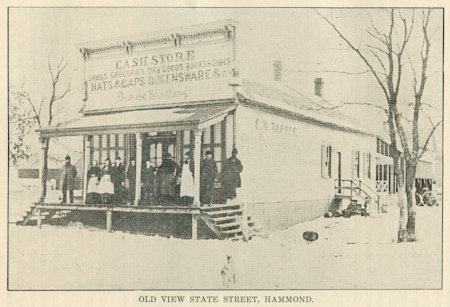
735
mond banks was approximately $200,000, and in 1910 $3,000,000. The present banks have assets approximating $17,000,000, and savings of about $6,000,000. The total bank clearings for the past twelve months are approximately $250,000,000. There are ten building and loan associations, with a. capitalization of $28,100,000, having stock in force of about $17,000,000, and assets of approximately $9,000,000. The Northern States Life Insurance Company is a vigorous growing institution which under the presidency of Dr. H. E. Sharrer has become a factor of importance in insurance circles in the Middle West and seems destined to be a force of the greatest moment in the financial life of Hammond.
Hammond has unequalled transportation facilities and its freight rate is the same as Gary and Chicago. The following steam railroads enter Hammond: Baltimore & Ohio Railroad Company; Chesapeake & Ohio Railroad Company; Chicago & Indiana Southern; Chicago, Indianapolis & Louisville (Monon) ; Erie Railroad (Chicago & Erie) ; Chicago Short Line; Grand Trunk Western Lines; Michigan Central Railroad Company; New York Central Railroad Company; New York, Chicago & St. Louis (Nickel Plate) ; Pennsylvania Railroad Company; Pere Marquette; Pittsburgh, Cincinnati, Chicago & St. Louis (Panhandle); Wabash Railway. The belt lines furnishing service to Hammond are: Baltimore & Ohio Chicago Terminal Railroad Company; Chicago & Western Indiana; Chicago Short Line; Elgin, Joliet & Eastern Railroad Company (Chicago Outer Belt) ; Indiana Harbor Belt Railroad Company, and the Belt Railway Company of Chicago. The following electric carriers give excellent transportation service: Chicago, Lake Shore & South Bend Railroad Company (South Shore Line); Gary & Inter urban Railway Company, and the Hammond, Whiting & East Chicago Railway, which furnishes the city street railway service. Bus transportation is maintained between Hammond and all nearby cities, including Chicago. There are approximately 2,200 railway employes who make Hammond their home, and have a yearly pay roll amounting to approximately $3,500,000.
A high percentage of passenger automobiles and trucks in proportion to the population are owned in Hammond, there being 9,405 passenger automobiles and 1,343 trucks. Hammond’s daily newspaper, the Lake County Times, with a circulation of nearly 20,000, is one of the most influential newspapers in Northern Indiana. Hammond’s industries, on account of their diversification, give great stability to the city and have more than 11,000 employes, and in addition there are approximately 3,000 Hammond workers who find employment in Chicago and in the various industrial cities in the Lake and Calumet Region nearby. The total industrial pay roll in Hammond establishments is more than $16,000,000. With the exception of the building and printing trades, nearly all industries operate under the American plan.
736

737
Hammond enjoys power and gas for household use at low rates, furnished by the Northern Indiana Gas and Electric Company, which supplies gas, electric light and electric power in Northern Indiana as far as South Bend, with the exception of the City of Gary. The company have 630 employes in connection with the various operations of the Hammond plants, and they have additional plants and interests throughout the Calumet Region. One of the most important power development projects in any section of the country is the power station of the State Line Generating Company now under construction on the lake front in Hammond, which will cost when completed between $75,000,000 and $100,000,000. Both the Western Union and Postal Telegraph companies have offices in Hammond. It is said the Western Union handles more than 20,000 messages every month. Telephone service is furnished by the Illinois Bell Telephone Company, who have approximately about 9,000 stations in Hammond.
There are six hospitals in Hammond, with over 500 available rooms for patients, including St. Margaret’s Hospital, which has 300 rooms. One of the evidences of the remarkable growth of the city has been in the postoffice receipts, which for 1926 approximated $316,000. The amusement loving people of Hammond have excellent opportunities to gratify their desires in stock, legitimate and moving picture productions, as there are six modern theatres, one of them costing $1,600,000. At the present time there are about 750 retail establishments, including several large department stores, and most anything sold can be found in Hammond. The city is yet in its infancy and seems destined to be the heart of a greater city to include the entire southern shore of Lake Michigan. The present tax valuation is $82,210,790.
The city officials are Adrian E. Tinkham, mayor; Homer J. Postlewaite, treasurer; Joseph W. Todd, city judge; Arnold H. Kunert, clerk; William H. Spellman, controller; Clyde Cleveland, city attorney; Ray Seeley, engineer; Emil Runde, chief of police; William Nill, chief of the fire department; Charles O. Schonert, superintendent of the water department; Clarence M. Eder, street commissioner; Charles Dowdell, building inspector; Ray F. Abbott, city electrician. Councilmen at large: Charles D. Benson, Roy G. Conde, Edward W. Hess, Howard R. Oltz, and Frank H. Seliger. Councilmen by wards: Columbus Smith, Peter L. Davis, Harry L. Dorton, Warner C. Sutherland, David W. Beach, John M. Hestenes, William M. Thompson, Peter J. Tanis Jr., Sigway B. Thorsen, John L. Graczwk, Charles N. Scott, George A. Muenich, and Fred Delolow.
738

739
GARY.
The great development in the steel industry in Indiana was through the foundation of the City of Gary, in Calumet Township, in 1906, by the Illinois Steel Company, one of the subsidiary companies of the United States Steel Corporation, and the building of its wonderful modern plant which followed and which is constantly being enlarged and improved. That there must have been sound economic reasons for the selection of the site of Gary for this new and important development in the growth of the industry in America is evident to anyone without reflection and, as study is given to the subject, it begins to dawn that the Lake and Calumet Region is ideally located to be a great steel center and that nearly every favorable factor of importance, having to do with the economic production of steel, was present in the Gary site. Within a short distance are the great iron ore deposits of the Lake Superior District, which made possible frequent trips by ore carrying vessels during the open lake season and with low water transportation charges. But a short distance from the Gary site are the enormous deposits of bituminous coal in Ohio, Indiana, Illinois and West Virginia, and great deposits of limestone — an essential flux — are available at Rogers, Michigan, and other convenient places.
The nearness of the bituminous coal deposits, with excellent railway transportation facilities from the mines, is undoubtedly a factor of outstanding importance, as the availability, adaptability and high calorific power of coal has not only made it the chief source of energy utilized by civilization but it is the chief metallurgical fuel, without which the high state of development of certain processes, like that of the blast furnace, would not have been possible. The availability of iron ore, fuel and flux to the Lake and Calumet Region, with low water and rail transportation charges, would be abundant reason for a great development of the industry in that section, but other additional favorable factors appear on close study, like unlimited water supply at hand, one of the greatest labor supply markets of America only a few miles away, thousands of acres of shore land available at but little cost, and railroad facilities almost unequalled, not only tapping many sources of material supply, but a means of distributing the products of the plants at favorable freight rates, to the markets in the populous and constantly growing Middle and Far West.
Through the above favorable and inviting factors a “Gary” was inevitable in the Lake and Calumet Region, and, through the United States Steel Corporation selecting the Gary site, the dreary, desolate, uninviting, sandy shore of that section of Lake Michigan in 1905 has undergone a transformation almost unbelievable, and through the establishment of the city many changes undreamed of at the beginning have so altered the former life and character of the entire territory bordering on the southern shore
740
of the lake that, looking back on the many historical events which rapidly unfolded themselves during the past twenty years, the history of Gary partakes more of the nature of a romance rather than a reality.
It is said it was not the original intention of the United States Steel Corporation to be active in the formation of the city, but that Judge Gary was convinced that the development of a modern up-to-date industrial community would need the active and material support of the United States Steel Corporation, and especially in the trying years of its infancy; so the formation of the Gary Land Company, controlled by the United States Steel Corporation, followed and available land for the purposes of the corporation and also for the foundation of the city was quickly secured.
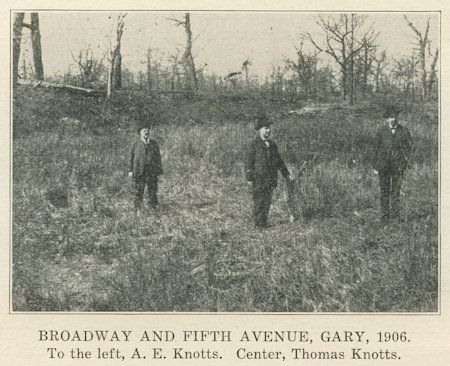
For a comprehensive story of these original activities, the reader is referred to biographical sketch of A. F. Knotts, one of the greatest factors in this period, which will be found in Volume II.
In the infant days of this new center of industry in the making came hundreds of daring progressive spirits, with clear vision minds with broad perspective. Here was opportunity for effort with the hope of reward, commensurate with the ability and genius applied to their activities, and their supplementary efforts in promoting the engineering, organization and administrative plans of the staff of the United States Steel Corporation were an invaluable aid in the broad plan of development which made possible the present progressive municipality conceived and carried through to such successful conclusion.
741
From the day that A. F. Knotts, president of the Gary Land Company, turned the first spade of earth, activity in every direction Followed. Building for a great future, broad avenues and thoroughfares were projected, a wonderful sewer system planned, and a waterworks system conceived which would assure an abundant supply of pure water for the coming large municipality, to which they gave the name of “Gary” in honor of the wonderful administrative genius, Judge Elbert H. Gary, who has guided the destinies of the United States Steel Corporation through so many years of success.
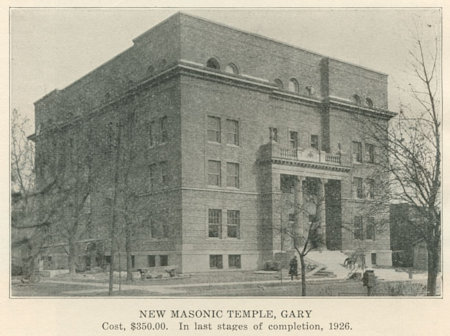
Information of the activities spread in every direction, bringing engineers, artisans and tradesmen of every kind, who were soon busily employed, and even members of some of the professions engaged in manual toil. In this formative period no factor of importance in the life of the future was neglected. Churches were planned, schools were established and the foundation of a library was laid. Enterprise, talent and ability among the citizens were quickly recognized by the United States Steel Corporation and men with special qualifications and talent were obtained and given an opportunity of carrying into effect the best ideas of modern thought and effort.
742
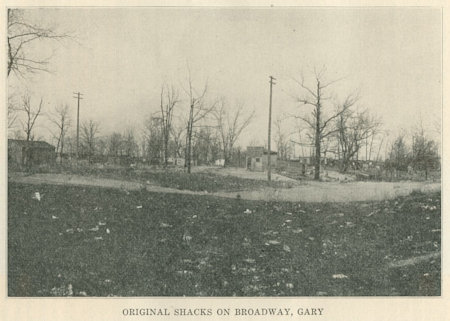
743
Lack, of space prevents the mentioning of the many talented minds who, with opportunity, demonstrated their capacity during this early period, and the light of whose genius is reflected in every direction through their contribution to the life of the city, in some instances of such vital significance that their work has become known to the limits of civilization. They cast upon the sand the witchery of their genius and the desert responded and blossomed like the rose.
One outstanding figure, who has made national and international as well as local history, through his work in one of the most important — if not the most vital department of the city’s welfare — is William A. Wirt, founder of the Gary plan of public school instruction. The Gary plan provides careful supervision of students in work, study and play, and through permitting the full use of the facilities of the school city, its economy of operation by contrast with other systems, added to its superior educational advantages, have given it the stamp of approval by leading educators, who pronounce it the one great outstanding contribution, in recent years, to the progress of public schools.
Another outstanding figure in the formative era is Col. A. P. Melton, so strongly identified with the plan for the reclamation of the Calumet marshes, and through the success of this project, which took years of effort, thousands of acres of heretofore useless land, where once the wild life held unfettered sway, have been converted into sites for business enterprise and happy homes, and where once the song birds thrilled their mates with their sweetest melodies, now resound with the silvery laughter of happy children, enjoying every comfort of modern civilization in one of the most prosperous industrial districts on earth.
The development of the industrial plants of the United States Steel Corporation were sensational in rapidity and thoroughness and a most pronounced illustration of extraordinary accomplishment by engineering genius and ample capital. A commodious harbor with ample dock facilities for the purpose of the mills was built and modern steel plants erected with every manufacturing convenience and improvement. From time to time additional plants were erected and the output of steel steadily increased until in this, the twentieth year from the beginning of the development of the industry in Gary, its steel plants line seven miles of lake shore and the production now equals or slightly exceeds any other steel producing center in the world. The growth and expansion of the city under the leadership of the Gary Land Company and its very able manager, Capt. Horace S. Norton, has been in accordance with the growth in industry, and the broad initial plans providing for every modern convenience for a large city are maturing as fast as conditions justify. It is a city of churches and its moral forces are the guiding influence in its
744
welfare. Its parks, its dunes and its beaches provide recreational advantages to an extent found only in a very few cities.
It is one of the great cosmopolitan cities of the country, with fifty-four different nationalities, all rapidly being assimilated. It is the heart of all nations in America, where all customs and all religions may be found, but with the spirit of America in every household. When we consider the short stage of its existence, it may be truthfully said of it that it is the wonder among all cities. Many facts of importance relative to its social, industrial and business life follow, which show its magic development in a single generation.
STATISTICAL RECORD — Gary is located in Calumet Township, Lake County, lying between Hammond and the Porter County line, its northern boundary being the shore of Lake Michigan. It is situated on a level site of fine sand, once a part of the bed of Lake Michigan, and the city is divided by the Grand and Little Calumet rivers. It is 589 feet above sea level and 19 feet above the level of Lake Michigan, and has an area of approximately forty-five square miles. There are about 160 miles of improved streets, 24 miles of paved alleys, nearly 150 miles of cement sidewalks, and a complete boulevard system of about 15 miles. There are yet about 175 miles of streets which will be improved as conditions warrant. The Illinois Steel Company maintains four bridges over the Grand Calumet River, while Lake County maintains the bridges over the Little Calumet River. The principal state and national highways, including the Ade Way, Dunes Highway, Huntington-Manitou-Culver Trail. Jackson Highway, Liberty Way, Lincoln Way, Michigan-Detroit-Chicago Highway, Chicago-Benton Harbor Trail, and the Yellowstone Trail, all enter Gary, bringing thousands of tourists to the city during the touring season. Sewage is disposed of through the Grand and Little Calumet rivers. While facilities are adequate for present needs, a survey has been conducted to ascertain and provide for requirements for the next twenty-five years. At present there are 47 district and nearly 130 local sewers, with approximately 100 miles of mains.
The water supply system is owned by the Gary Heat, Light and Water Company. The water, procured from Lake Michigan, is brought to the city through a concrete tunnel from a submerged crib located 1.5 miles from the shore and 44 feet below the surface, and the water is treated with liquid chlorene. There are nearly 100 miles of water mains and the present capacity of the pumping units is 38,000,000 gallons daily, and of the tunnel 80,000,000 gallons daily, sufficient to serve a population of 250,000. Alternating current, 6,600 volt, 25 cycle, 3 phase, for all commercial and industrial purposes is generated by the Illinois Steel Company, sold to and distributed by the Gary Heat, Light and Water Com-
745
pany. Washed blast furnace gas operates thirty-four 3,000 H. P. engines, each of which generates 2,500 K. W. Four substations located advantageously about the city distribute and step down the power from 6,600 to 2,300 volts. The Calumet Gas and Electric Company, which maintains its general offices in Gary, serves seventy-three communities in Northern Indiana. It supplies electrical energy for the operation of the Gary Street Railway, Gary & Hobart Traction Company, and the Gary & Valparaiso Railway Company, but does no commercial or residential business in Gary. Its power is supplied from the 132,000 K. W. super-power substation at Aetna, just east of Gary.
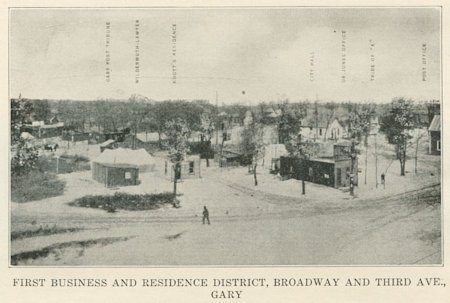
Gas for all commercial, industrial and household purposes is manufactured at the coke ovens of the Illinois Steel Company, sold to and distributed by the Gary Heat, Light and Water Company. The production of the ovens is 140,000,000 cubic feet of gas per twenty-four hours, and the company has the second largest gas holder in the State of Indiana. The city is exceptionally well lighted through 700 arc lights, and the business district contains thirty-five blocks of ornamental lights. There are 140 miles of electric light lines, and through joint use by utilities there are a minimum of electric poles throughout the city, as nearly all the wires in the business district are carried in underground conduits. The Gary Street Railway owns and operates the street railway system and serves
746
every residential, recreational and industrial section of the city. It is generally recognized as the most efficient city railway system in Indiana. About 100 cars are in operation on ninety miles of track. Auxiliary motor bus service assists the street railway system in certain sections of the city, and interurban motor coach lines are in operation between Gary and nearby cities, as well as Chicago.
Six trunk line steam railroads, including the Baltimore & Ohio, Michigan Central, and New York Central, Nickel Plate, Pennsylvania and
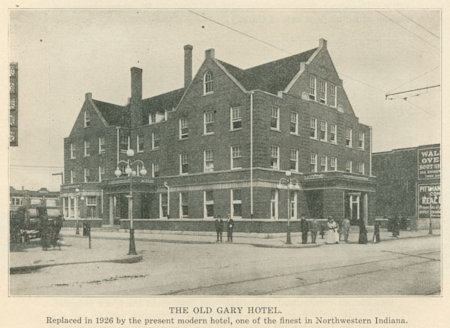
Replaced in 1926 by the present modern hotel, one of the finest in Northwestern Indiana.
Wabash railroads, furnish almost unequalled transportation facilities. The Elgin, Joliet & Eastern and the Indiana Harbor Belt Line furnish excellent service to the industries in Gary, and there is belt line freight shipping connections with every railroad entering Chicago. The rates for freight in the Chicago freight zone prevail in Gary, and it has one of the largest railroad freight yards in the Middle West, with sites acquired for three more additional yards. The Chicago, South Shore & South Bend Electric Railroad and electric interurban lines to Crown Point, Hammond,
747
Hobart, Indiana Harbor and Valparaiso furnish rapid and safe service to the cities mentioned.
The Illinois Bell Telephone Company furnishes excellent service and there are more than 8,000 telephones in use. The Western Union and Postal Telegraph companies furnish telegraph and cable communication all over the world. Gary is rated as a second class city by the Indiana Inspection Bureau and has a most modern motorized fire department. There are six fire stations and about ninety firemen, and the stations and equipment are valued at $175,000. Its waterworks system from a fire protection standpoint is of the highest rating, a minimum water pressure of 50 pounds, capable of instant development to 100-110 pounds, is at all times maintained. The police department is an excellent organization, intelligently conducted by experienced and well qualified officials, and the patrolmen, park and traffic officers are noted for their courtesy and good judgment. There are about 120 policemen and policewomen. Careful attention is given to the health of the city and the city health department is well organized and well maintained. It has under its direction a modern laboratory for the inspection and analysis of milk, water and food and for the control of contagious diseases. Gary has some first-class hospitals, including the Mercy Hospital, with 140 beds, and the Methodist Hospital, with 100 beds, both hospitals having schools for nurses.
The Gary city park system contains over 525 acres, all located within the city limits and divided into the following well improved municipal parks: Westside Park, Eastside Park, Tyler Park, Tolleston Park. The new lake Front Park on Lake Michigan is one of the most attractive spots on the south shore. There are 150 acres of natural woodland with a level beach of two miles long. A new $160,000 municipal bathing pavilion and a $200,000 recreation pavilion on the park beach are examples of the city’s interest in providing facilities to promote health and recreation for the citizen. The average number of workers employed in the Gary industries is more than 30,000, and 90 per cent of the workers are male and are employed in several units of the United States Steel Corporation. Nearly all civilized countries are represented through these employes. The school census of 1925 shows there are fifty-four nationalities represented in the population in Gary. The American white population is 37 per cent; the American colored, 14 per cent; Polish, 11 per cent; Slavish, 7 per cent; Austrian, 4 per cent; Hungarian, 4 per cent; Croation, 4 per cent; German, 3 per cent; Italian, 3 per cent; Russian, 2 per cent; and all other countries, 11 per cent.
Fifteen banks and trust companies have deposits of approximately $18,321,628.49, and approximate total resources of $21,417,562. Bank clearances for 1926 were $322,544,570. Fourteen building, savings and
748
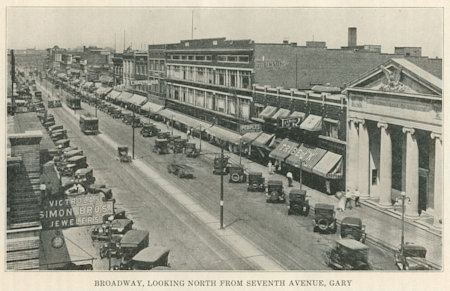
749
loan associations have assets of nearly $5,000,000, and stock in force about $10,000,000, and are assisting materially in caring for the housing requirements of the city. Among the new modern buildings are the Elks Temple, costing $300,000; the Masonic Temple, costing $250,000; the Palace Theatre, costing $1,000,000, and there are nine other theatres. The city is enjoying a phenomenal growth and keeping pace with the industrial development. During 1926 the amount invested in new construction, not including that expended in industrial plants, was approximately $22,000,000, and in building operations for some time Gary has ranked among the leading cities of the country, only exceeded by some of the very largest centers of population. At the present time the Knights of
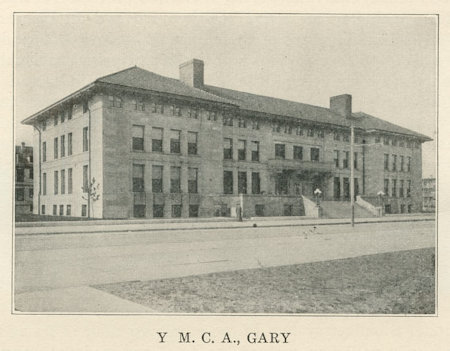
Columbus have a million-dollar skyscraper under construction, and a new modern fireproof hotel twenty-one stories high, to cost $2,500,000, is being erected on the site of the old Gary Hotel.
In 1919 the city appointed a city planning commission to develop a comprehensive city plan for the future growth of Gary, and Messrs. Bennett and Parsons, city planners of Chicago, were employed by the commission to assist them in the project. The zoning ordinance prepared by the city planning commission has been adopted by the city. Another important development adopted by the city, which was promoted by the Gary Commercial Club, is the Gary Gateway and Railway Development, providing for the erection of new freight and passenger facilities, the opening and widening of new streets and boulevards, and the beautification of that territory lying between Fifth Avenue and the property of the Illinois Steel Company. It has one of the best newspapers in the Middle
750
West, the Gary Post-Tribune, not only a great news sheet, but active in every movement to promote the welfare of the city, and it has outstanding influence. There are twenty-one labor unions, with more than 600 members, who are mostly identified with the building and printing trades, as nearly all other establishments are operated under the American plan.
The postoffice receipts have steadily increased year by year, and for 1926 were $247,389, a gain of 18 per cent. The private lake harbor receives about 400,000 tons of ore annually, and a second harbor is building. The city has an industrial pay roll of about $50,000,000, with a per capita wealth of more than $1,600. Its schools are a model of excellence and will be found more fully described in the chapter on schools. Gary has 500 social, charitable, civic, fraternal, professional and religious organizations, including an active realty board and an insurance board composed of leading members of their lines of business. Included in this number are about 150 social clubs and the five principal national luncheon clubs. The Gary Commercial Club, Indian Ridge Club, and the Gary Country Club have large memberships among the business and professional life of the city. Visitors have no trouble in getting accommodations in Gary, as there are sixty hotels and some first-class rooming houses.
Nearly every religious denomination finds expression in the city. There are 39 Protestant, 12 Catholic, 2 Hebrew, 4 Greek Orthodox, and 9 miscellaneous churches. There is a $560,000 Y. M. C. A., donated by Judge Gary, and also a $125,000 Y. W: C. A., which has 600 members. More than 1,000 retail stores carry on a successful business, and the quality, selection, moderate price, and diversity of merchandise is not excelled in the larger cities. The professions are strongly represented in Gary, there being about 100 lawyers, 100 physicians, and 50 dentists. The city operates under a budget system in the administration of its affairs. The bonding capacity is 2 per cent of the total assessed valuation of more than $160,000,000, and the oustanding issues, which are mainly for improvements and refunding purposes, are only a small part of its capacity.
The city has the aldermanic form of government, five aldermen being elected at large, and one from each of the city’s ten wards. The present mayor, Floyd E. Williams, is an outstanding citizen with a comprehensive grasp of the needs of the city and with a forward vision as to the requirements of the greater Gary that is to come. With the mayor, the following are the present city officials: Comptroller, Lloyd B. Snowden; clerk, John J. Dwyer; treasurer, John R. Lane; engineer, William P. Collingham; inspector of plumbing, Grover C. Elkin; city attorney, Oliver Starr; building commissioner, William G. Bowman; chief of police, William J. Linn; chief of fire department, Wilfred Grant; street commissioner, Wilbur Nusbaum; superintendent of streets, William H. Bigelow; health
751
officer, Christopher M. Reyher; park superintendent, William H. DeGran; city judge, Cassius M. Greenlee. Aldermen at large: Otto V. Gray, William J. Hallas, Evan M. Hess, Merritt Martindale, and Roy P. Smiths Aldermen by wards: First Ward, Albert W. Brown; Second Ward, Ralph E. Rowley; Third Ward, William E. Burrus; Fourth Ward, Samuel R. Blackwell; Fifth Ward, A. B. Whitlock; Sixth Ward, Lloyd M. Gorrell; Seventh Ward, Charles H. Wheeler; Eighth Ward, Samuel W. Cullison; Ninth Ward, George W. Hilton; Tenth Ward, Floyd S. Stickney. Board of health: Dr. Christopher M. Reyher, president; Dr. Byrum W. Harris, secretary, and Dr. Antonia Giorgi; Mrs. Rose O. Smith, clerk; Frank Mallis, sanitary inspector; William H. Webber, food inspector; Mrs. Eliza-
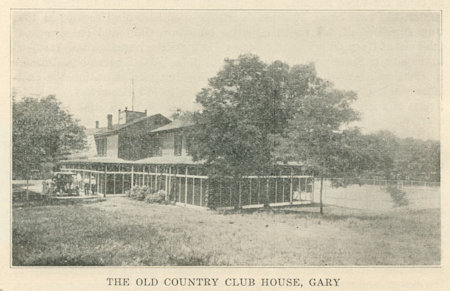
both C. Hadley, nurse. Board of public works: Chester J. Dunn, president; John A. Brennan, and Harry L. Arnold. Board of public safety: Harold Sandback, president; J. Ralph Snyder, and Walter J. St. John. Park commissioners: William P. Gleason, president; Louis H. Gleuck, secretary; C. D. Davidson, and Frank Borman. Trustee of Calumet Township, Mary Newlin. Assessor of Calumet Township, John McFadden.
The offices of mayor, city clerk and city judge are elective, but all other offices are appointed. The present population of the city is approximately 110,000.
GARY POSTOFFICE — Gary’s first postoffice was established July 11, 1906, in a story and one-half frame building owned and used by the Gary Land
752
Company as a real estate and field engineer’s office. The building was located on the land now occupied by the Chicago, Lake Shore & South Bend Railway Company’s depot on North Broadway, near Third Avenue, then known as Euclid Avenue. Thomas E. Knotts was commissioned postmaster July 1, 1906. His office furniture consisted of a dry goods box for a counter, a soap box for a chair, and a shoe box as a means of distribution of mail. The first day’s cancellation of postage stamps, which was the postmaster’s salary, was SI.61, and the cancellation for the first three months amounted to the magnificent sum of 8160.85. Nevertheless the enterprising postmaster installed lock and call box equipment, and the first lock box was rented to the firm of Connors & Johnson, the rate being 20 cents for three months. The first call box was rented to Henry Carpenter, the rate being 10 cents for three months. Mail service at that time consisted of one pouch of letter mail into Gary and one pouch of mail out of Gary daily except Sunday. In 1907 the postoffice was removed to the Knotts Building at 704 Broadway. John W. Call became postmaster in 1908, and served until 1915, and during his administration the postoffice was moved to 505 Broadway and later to 519 Broadway. The delivery of mail by city carrier was established June 15, 1909; the first carrier appointed at this time was Jacob T. Huff, who is still connected with the postal service, in charge of the registry section of the office. The Postal Savings Bank was opened on May 1, 1911, with Joseph C. Tracy in charge. Mr. Tracy later enlisted in the Military Postal Express Service and served overseas during the World war, and like many other young men from Gary found his last resting place on foreign soil. The first account in the Postal Savings Bank was opened by Joseph Edwin Conway, a local newsboy, who deposited $1. The bank grew rapidly until the total aggregate deposits were approximately $900,000. On January 1, 1913, the parcel post system was established, and this first day will be long remembered in the postoffice, as a local material dealer took advantage of the system and mailed 500 face brick samples to his friends and customers. The volume of business in the last quarter of Mr. Call’s term as postmaster in 1915 amounted to $14,169.53. Henry B. Snyder succeeded Mr. Call as postmaster, and during his administration two fifty-mile motor rural routes were established, covering slightly more than 100 miles of rural territory. At the present time these routes are serving 770 families, or a rural population of more than 4,000 people. The routes pass through the towns of Miller, East Gary, Hobart, Highlands, Schererville, Griffith and Ross. During the year 1917 the parcel post business became so heavy that horse drawn vehicles were replaced by motor vehicles for delivery of this class of mail. On May 1, 1916, the postoffice was moved from 519 Broadway to the Federal Building, corner of Fifth Avenue and Adams Street. The beautiful building now occupied as a postoffice was made
753
possible by the Gary Land Company, who donated the site on which the structure stands. In the last quarter of Mr. Snyder’s term the receipts amounted to $30,711.46, having doubled in four years. Mrs. Edith B. Melton assumed charge of the postoffice as acting postmaster on November 16, 1920, and served for 13VS months until the present postmaster, Alfred S. Hess, took charge. Under Mr. Hess’s administration the postoffice service has materially broadened and the many problems encountered peculiar to a city like Gary, with its many nationalities and rapid industrial growth, have been mastered by Mr. Hess with great success.
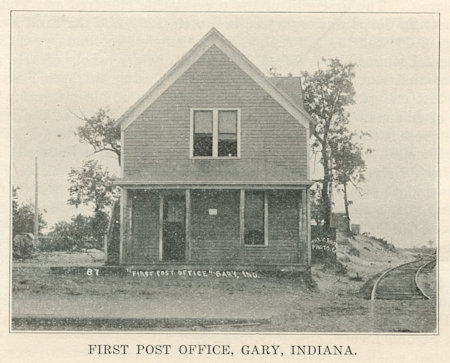
At the present time Gary has 21 outgoing and 35 incoming mails each day. More than 150,000 pieces of first-class mail are handled each twenty-four hours. Four substations have been established in Gary, all of them being stamp, money order and parcel post stations. In addition is the independent postoffice at Miller, now the Tenth Ward of Gary. Fifty-five people are employed by the office in addition to the supervising department heads. The postoffice receipts were $247,389 for 1926.
THE GARY STATE ARMORY AND THE ONE HUNDRED AND THIRTEENTH ENGINEERING CORPS.
The construction of the Gary State Armory, which is the center of military activities in the Lake anD Calumet Region, was commenced in the month of November, 1923, and completed in May, 1924. The site of the
754
armory was one of the many gifts which has distinguished the Gary Land Company in the upbuilding of the city and was worth more than $40,000 at the time it was presented to the state and is now valued at more than double the price. The dimensions of the armory are 75 by 150 with a drill hall 75 by 105. There is a full basement for storage, half of it above ground. The approximate cost of the armory was 8100,000. It is occupied by the following units of the One Hundred and Thirteenth Engineers Regiment: Regimental Headquarters, Headquarters First Battalion, Headquarters and Service Company, Company A, Company B and Company C. The first unit of the present One Hundred and Thirteenth Engineering Corps was organized in March, 1921, and the First Battalion in May, 1921, and the full regiment was complete in January, 1922. The regimental commander is Col. A. P. Melton, of Gary, whose great engineering accomplishments both in civil life and during the World war have made him one of the most prominent members of his profession in the State of Indiana. The following is a list of the officers of the regiment at the present time: Col. Arthur P. Melton, Lt. Col. Ernest C. Simpson, Major Frank L. Gray, Major Joseph V. Brennan, Major Robert C. Hamilton, Capt. Nelson D. Lambert, Capt. John W. Newsom, Capt. John F. Drummond, Capt. George E. Comstock, Capt. Phillip Forsberg, Capt. Alex D. Torie, Capt. Hans H. Skabo, Capt. James C. Forbes, Capt. Raymond M. Jones, Capt. Claude P. McNeil, First Lieut. Harold H. Feierabend, First Lieut. John F. Headlee, First Lieut. Fred S. Feulner, First Lieut. Robert A. Miller, First Lieut. Lloyd H. Chaney, First Lieut. Elbert D. Curtis, First Lieut. Oscar A. Ahlgren, Second Lieut. Harold J. Hocker, Second Lieut. John J. Flynn, Second Lieut. William R. Meade, Second Lieut. Kenneth F. Shepherd, Second Lieut. Frank J. Scott, Second Lieut, Harold T. Lentz, Second Lieut. Louis F. Brossard.
THE EARLY DAYS OF GARY.
By Hon. Ora L. Wildermuth.
My attention was first called to the proposed City of Gary by certain newspaper articles appearing in the Sunday newspapers in the spring of 1906. The articles did not definitely locate the city except to indicate that it was to be somewhere along the shore of Lake Michigan, in Indiana. I was then just completing a law course in college and naturally the news that a new city was to be built attracted my attention. These notices, however, were so meager and uncertain that I was somewhat doubtful about the wisdom of even investigating the place. However, a young dentist in my home town proposed to me one day in July that we visit the proposed town site and we fixed several dates for the expedition, but each time the dentist found some excuse for delaying the trip. Finally we
755
agreed to go on August 1, 1906. However, when the train came along, in the afternoon, he backed out and I was compelled to go alone.
The station agent was not able to give us any information as to how to find the place, so I boarded the train without a ticket, hoping that the conductor might be able to give me some directions as to connections. His best information was to the effect that if I left the train at Hartsdale I could get to Gary on the E. J. & E. or the Michigan Central Railroads. Accordingly I landed at this railroad crossing sometime in the night of August 1. I found the place consisted of a railroad crossing with a telegraph office and an interlocking plant. The nearest town, they said, was Griffith, two miles away, to which place I went on a freight train that happened along. At Griffith I was unable to get any information about this place called Gary, and nobody seemed to know about it.
The boarding houses were full and I spent the night with a telegraph operator on the Grand Trunk Railroad. He thought I might be able to get to Gary by taking a train on the Michigan Central the next morning. When morning came the ticket agent advised me that his train went the other direction in the morning and I could not go to Gary until evening, and he was uncertain as to how far I might be from the town when I left his road. Again an E. J. & E. freight train came along and the conductor of this train learned of my plight and offered his assistance. He said he knew right where they were building the Tow of Gary and that if I would come with him he would take me to Indiana Harbor, where I could get a train to Gary.
I arrived in Gary at 11:55 on the Lake Shore Railroad on August 2 in company with two traveling men who were thinking of locating in business in the new city. The railroad station was a box car and the neighborhood was all sand. We walked south from the box car some little distance when we came to a frame building, which looked like a residence but which was evidently used for business. We learned it was the postoffice and went in to inquire how far it was to the Lake Shore Depot and the young man said it was about a hundred yards. It seemed to us that we had walked at least a mile and we were fearful lest we could not get back in time for the 5 o’clock train. One of my comrades asked if there was any mail for him and the attendant leafed through the letters which he kept in a pasteboard shoe box, after which he looked up to this fellow and said “What is your name?” He gave him the name and the postmaster said, “No, there is no mail for you.” I learned later the young man keeping the postoffice was Frank Knotts, the son of the first mayor, and who gave his life in France during the great war.
I spent the afternoon scouting about the sand hills and sloughs, trying to talk to as many people as I could and getting very little information. No one that I found seemed to be very sure of just what was going to
756
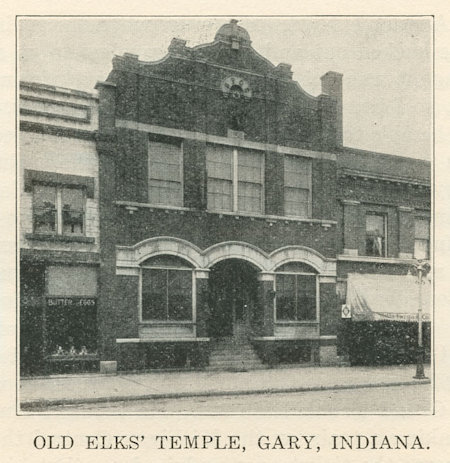
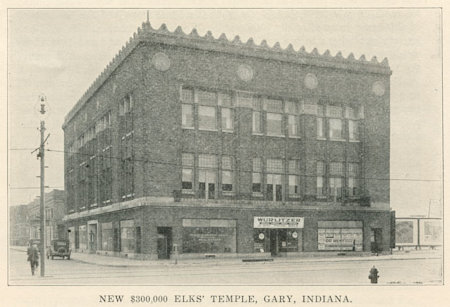
757
happen. Everywhere you went men were working but the plan was so big that they did not seem to realize the purpose of it. Here we found them grading a street, and there digging a ditch, and over along the lake they were erecting tremendous concrete mixers preparatory to putting in concrete foundations. The whole thing looked like a gloomy outlook for a young man who hoped to be looked upon as a rising young lawyer. Yet it seemed worth further investigation. There were no hotels or boarding houses save those maintained by the various contracting concerns where they housed and fed their own men. In other words, there was no place for you to stay unless you had a job, so I procured a job with Lanquist & Illsley, a Chicago contracting concern, who were to build concrete foundations for the steel mills. I thought I might as well study the thing from the ground up.
I worked there during the months of August and September, 1906, during which period I spent a great deal of time looking the neighborhood over. The plans for the mills looked big, and day after day the plans for the city seemed to develop, and I thought it was a good place to stay. One of the first men I became acquainted with was the postmaster, Thomas E. Knotts, who was also the president of the town board, and who later became the first mayor of the city. He had at one time lived in my home county and he and my father had taught school together about the time I was born. He told me one day, in the course of our conversation, that they had decided to have a school in Gary the coming winter if they could find a teacher. He asked me if I didn’t want the job, and I agreed to take it. They had no school board yet, but there was one appointed a few days later and after their appointment they confirmed my employment.
The school was to begin on the first day of October, but the building was not completed, so I called the children together by standing on a stump in front of the school house and ringing a bell which the school board had furnished me with that morning. The bell together with a box of tablets of writing paper was all the equipment we had. The school house was a one story frame building with a gable roof, the building being about twenty feet wide and thirty feet long, with one room. The doors and windows were put in that day but we had no seats or benches. I helped the carpenter and we made seats upon which the children might sit the next day. These seats were made of planks ten inches wide and one inch thick, supported by blocks nailed to the floor. The next day we had a session of school. We had but few books besides the writing tablets, and it was difficult to write on these for we had no desks, and the children’s backs got tired. I suggested to the carpenter that we ought to put a back on the seats and this we did after adjournment. A few days later we put another board up in front of the seat and made a desk of it. The boards reached clear across the school house. I tried to get the carpenter
758
to cut them up into pieces and make small seats but he said this would entail too much waste of lumber. Later some seats were procured, and still later another school house was built when it was found that we had too many children for one room.
During the fall someone suggested that the children ought to have some books to read. I won’t undertake to say who it was that made this suggestion but it was this suggestion that really was the beginning of the Gary Public Library. At any rate we took up the suggestion and some of the good women of the neighborhood arranged an oyster supper to be held in the school house. I hadn’t much faith in the oyster supper. Most of the men who worked in the place then were tramps and hoboes with no family ties or connections and it is hard for me to believe that such men would have much interest in civic affairs. Yet the women persisted and when the oyster supper was given many of the men came from the camps that were scattered through the woods, and we had quite a charming success.
With the money raised by this means some books were bought. We thought there might be danger in leaving these treasured volumes in the school house because it was frequently opened at night by stragglers who crept in and stayed over night, so the books were taken to my office, a tar paper covered shanty across the waste of sand called Broadway, opposite the school house, which building served me both as office and residence. No one here knew anything about libraries so far as I could find, but the children and I devised a scheme for keeping track of the books which we did by means of some pasteboard cards made by one of the little girls from some cardboard she got out of a cracker barrel. The scheme for the establishment of the public library was really worked out by Superintendent Wirt, who came to Gary in 1907. I remember well when he sent for me one day and said that with all due respect to our collection of books he thought that in time they might prove inadequate and that we ought to take steps to improve the library facilities. He said he thought I ought to be a member of the library board because anyone who had the nerve to start a library from an oyster supper surely had library interests at heart.
We found the law required a five years residence qualification for library board members, and there wasn’t anybody in Gary qualified to serve, so we organized a school board library but selected an independent library board who were without legal authority but who sat in regular monthly meetings and determined all questions of policy concerning the library and whose decisions were always followed by the school board in order to make the actions legal. Louis J. Bailey was employed as librarian in the summer of 1908 and the public library opened in the fall of 1908 in a store room on Seventh Avenue just west of Broadway. We soon outgrew a little store room and took an additional room adjoining it. Shortly
759
afterwards we moved to a double store on the west side of Washington Street between Sixth and Seventh. From here we moved to the present Central Library on Fifth Avenue. I need not trace the development of the public library further because the rest of the record is already a matter of history. During the fall and winter of 1906 and the spring of 1907 Gary had much the appearance of a western boom town. A number of families lived here but they all resided in tents or shanties covered with tar paper. Several of these families lived in tents during the entire wintei of 1906 and 1907. We had no electric lights, water system, sewer system, gas, or other utilities. We lived as backwoodsmen, and indeed it was the backwoods in many respects.
One incident that I well recall illustrates the nature of the settlement. Pat and Dan Fitzgerald had opened a hotel where we all stayed. It was a temporary frame building which stood in what now is the front yard of the Illinois Steel Company’s Hospital. Just north of it was McFaddens Flats, operated by John McFadden, later township assessor. The “flats” were arranged after the style of an overgrown sleeping car. I roomed for some time with C. Oliver Holmes, now the president of the South Side Trust & Savings Bank, and a member of the Indiana State Senate. Our room in the hotel was so small that we could not both get in the room at once unless one of us was in bed. We had to retire and arise at different intervals. Around the stove at-the hotel one night conversation turned to wildcats. Someone suggested that he had seen a wildcat in the woods at Gary. Three of us laid a little plan and we saw to it that the talk about wildcats was taken up each succeeding evening for several days. There was a gang of men stopping at the hotel who were drilling test holes measuring the depth of the sand on a line running from the present water tower in Jefferson Park north to the intake in the lake. They worked two shifts and changed about weekly. About 10 o’clock one night of the next week when the one shift were working nights we three sneaked out of the hotel to the place where these men were drilling their test holes. One fellow whose name I can no longer remember, said he knew what kind of a noise a wildcat made. The other two of us had never seen a wildcat. This fellow who knew the wildcat’s yell when he came to within about a hundred yards of the drilling operations, gave forth some sort of a yell which he said sounded like a wildcat, and the drillers all climbed the derrick. It was a perfect moonlight night and we sat out there in the willows on the sand until well after midnight, with our wildcat man occasionally letting out a yell and keeping the drillers up the derrick. We finally went home and they told us the next morning a most graphic story of how they were attacked the night before by a pack of wildcats who came so close to the derrick they could see the flash of their eyes as they neared the bonfire. They told of how they chased them away a time or
760
two with fire brands. On their way to the hotel when they left their work in the morning they met Tom Knotts and told him their story and he said that he had no doubt but that it was true, although he did not know anything about our trick.
Gary was a busy place in those days. Everybody had to work, and we began to acquire a reputation of being a boom town. I built my little shack, which became my office and my residence, on the west side of Broadway about two hundred feet north of what is now Fourth Avenue. There were no paved streets then. The school houses sat just a little further north of that on the other side of the street, and the postoffice was perhaps two hundred feet north of my shack. We built the place after school at night and on Sunday when I could obtain the services of a carpenter, and it was a couple of weeks in the course of building. On Hallowe’en night the frame work was up but there was no roof or siding on. Some boys, to play a prank on the teacher, found an old box sign with lettering on either side saying “Rooms for rent by the day or week.” They nailed this thing up on the frame of my shanty and put a lantern inside so that the letters might be read. A visitor who had come out from Chicago and strayed a little too far in the sand hills, as people were wont to do in those days, did not get back to the station in time for the last train, which left at about 6 o’clock. He began to look for a place to stay and finally saw this sign through the woods and went to it only to find the frame of this little shack. He didn’t know about the Hallowe’en prank but thought the sign was really placed there by the owner of the building in order that he might have trade ready for him as soon as the building was completed. I heard him tell about his experience at the postoffice a little later when he said he had always heard this was a boom town but he had no idea it was as bad as that.
The law business began to develop during the winter of 1906 and 1907. I tried a few cases during the winter, the court being held in the evening when I did not have to be in school. Ex-Mayor Hodges and I had an office together a little while but his story about our first case and first fee is not entirely true. Two justices were elected in the fall of 1906 and they soon began to dispense justice. I well remember the first civil case ever tried. I had to prepare all the papers and dockets for the justice, who was a hotel keeper. One lawyer preceded me to Gary. He was one of the drillers referrd to in the wild cat story. He did not stay long and I have never heard from him since. William F. Hodges came during the winter and Claude V. Ridgely came next. I cannot remember the order of their coming after that. Of course A. F. Knotts was here before I came, but both his office and residence were in Hammond.
In the spring of 1907 Hodges built a residence at the southwest corner of Sixth Avenue and Virginia Street. This was the first permanent house
761
built in Gary. I built a house at 610 Jefferson Street and this was the first completed home west of Broadway and the second in the town. Mayor Knotts started his home at Seventh and Adams before I began but his plans were somewhat more pretentious and I beat him done. Joseph Fro.st came afterwards and houses grew like mushrooms. I remember once when a client of mine contracted with Frost to buy a house yet to be built. The ink was hardly dry on the contract when T. W. Englehardt came along and we leased it to him. He was anxious to move and Frost promised to hurry. This house, on the east side of Adams between Sixth and Seventh avenues, was started the next morning and the Englehardts had dinner in it the next day. It was a modern seven room house. Things moved fast from then on. I would not trade my experiences in watching Gary grow up and in some ways growing up with it for anything else I can think of, yet I would not care to repeat the performance.
EARLY RECOLLECTIONS OF GARY.
By Col. A. P. Melton.
Through the courtesy of the Gary Historical Society.
To one who has lived in this community for a number of years, an extended discourse on early experiences and impressions might be tiresome. Such a talk must sound more or less commonplace and must necessarily contain statements that are not new or original to all. However, the real history of the early days of Gary will consist of the narratives of individuals, compiled through conscientious effort by some one who only seeks to portray that which he finds, rather than a good historical “story” from some one with an active imagination and a facile pen.
My first appearance in Gary occurred more than sixteen years ago, having been employed by the steel corporation as engineer on the town site. I came out in company with Mr. Ralph Rowley and Mr. Thomas H. Cutler, engineers, on the B. & O. milk train which arrived at what was then Calumet Heights station about 4 o’clock in the afternoon. This station was located about a mile northeast of the present station and near the present location of the blast furnaces, it being used by members of a club of Chicago who had a club house and a number of cottages on the lake front near the present harbor. After tramping about a mile and a half through the woods to the club, my enthusiasm for the Gary that was to be had about reached the vanishing point, and I longed for the bright lights of Chicago. After meeting some old friends and having a good man-size meal, my courage came back and with following busy days of planning and executing work, professional interest in the development of the great works became the paramount issue and pushing the work the order of the day. My first work on the town site started during the latter
762
part of April, 1906, the first job being the construction of a temporary pile bridge across the Grand Calumet River just west of the present concrete structure, which was followed by determining the center line of what was to be Broadway and next the line of Fifth Avenue. The Grand Calumet River at Broadway consisted of a stream about one hundred feet wide and a marsh about five hundred feet wide on the north side.
There was nothing to mark the line where Broadway was laid out, as the whole tract was a series of sand hills and sloughs, the hills being covered with scrub oaks and the sloughs supporting a dense vegetation of marsh grasses and shrubbery. The marshes were a series of long narrow sloughs extending in a direction parallel to the shore line of Lake Michigan and some of them were quite deep. One in particular was that about one hundred feet north of Sixth Avenue, it being about seventy-five feet wide and five or six feet deep, with a considerable depth of soft mud or muck in the bottom. Its western end was near the Episcopal Church and it extended east to where it intersected the New York Central Railroad, perhaps more than a mile. When our surveying party was measuring Broadway and came to this slough, one of the chainmen made several unsuccessful attempts to throw his tape line across but on account of dense willows and other vegetation could not get it over, so he started to wade across but gave that up when he started to sink down in the soft muck bottom. One of the residents of the old town of Tolleston was around looking on as was also his dog. The chainman conceived the idea of tying the tape line on the dog’s collar, throwing a stick across the slough, sending the dog after the stick and then having the man on the other side call the dog—thus was the first engineering -obstacle overcome, and thus, by this homely little incident, was the City of Gary extended beyond this obstruction. It is regretted that it is not possible to chronicle here the name of the Tolleston native and also the name of his dog. The dog has no doubt passed to the happy hunting grounds of dogdom ere this, but let his memory as an unknown benefactor be preserved for all time in the archives of the Historical Society.
After Broadway had been surveyed to the extreme south limit of the Wabash Railroad right of way, Fifth Avenue was taken into consideration. When we arrived about Monroe Street on Fifth Avenue we encountered a very dense swamp jungle in the bed of a creek known as Gibson Run and a day was required to get a line through from Monroe Street to Jackson Street when we again got up on the sand hills. No special difficulties were encountered for some distance with the exception that the front chainman would occasionally stir up a colony of yellow jackets or hornets, which said colony generally acquired a proper degree of wrath and indignation to induce considerable activity in the rear chainman by the time he came along. At Fillmore Street and Fifth Avenue stood a mighty oak,
763
the largest in the subdivision, and as all the men’s hands were blistered, your narrator volunteered to cut this giant of the forest. Major Cutler, one of the first engineers on the steel mill work, came along about this time and he verified the measurement, which was about an inch over three feet in diameter.
The first subdivision had some attractive features even at that time. Near Sixth Avenue and Delaware Street was a very luxuriant patch of blue berries which could be stripped off the bushes in great handfuls, while near the Wabash Railroad was the best strawberry patch. It was always well to look carefully before one sat down on the ground for there was an abundance of cacti, and its thorns were very painful. Then again there was a surplus of spreading adders, a very wicked looking snake, and a rather aggressive one, too, while in the swamps could be found an abundance of moccasins, bull snakes, frogs, turtles and muskrats.
When grading Adams Street there was a large hill at the western terminus of the slough described as near Sixth Avenue. This hill was just about in front of the Episcopal Church and was about as high as the church. On the topmost peak of the hill we uncovered, buried at a depth of only about one foot, some human bones. We collected all we could find and Dr. F. M. Jones, one of the pioneer Gary physicians, stated that there were remains of five people, two men, a woman, and two children. These bones were pretty well disintegrated and the skulls fell to pieces when we handled them. They were in such condition that it could not, be determined whether or not they were white or Indian.
Gibson’s Run was a considerable creek that drained the marshes south of the Wabash Railroad. It had its origin at Seventeenth Avenue and Jefferson Street, and collected the water from several of the sloughs between Seventeenth Avenue and Tenth Avenue. The course of the stream was about on a line with Jefferson Street up to Tenth Avenue, when it shifted over to about the alley west of Jefferson Street and continued almost straight north to Fifth Avenue, where it turned west to about Jackson Street, turning again in a northwesterly direction from there on its course to the Grand Calumet River.
Remains, such as charred wood and broken crockery, were found on the northeast corner of Fourteenth Avenue and Madison Street, and it is supposed that this was from the old Gibson Inn, which it is said was located here. A trail from Aetna and points east crossed Broadway at about Fourteenth Avenue and meandered through the woods to the west, crossing Gibson’s Run somewhat south of Fourteenth and Jefferson streets, crossing Madison Street at about Fourteenth Avenue, then turning north about on Madison Street to about Eleventh, then bearing slightly northwest and crossing the Michigan Central Railroad just west of the present
764
Madison Street crossing, then continuing west to Tolleston between the Wabash and Michigan Central railroads.
There was no crossing over any of the railroads on Broadway at that time, although a portion of Broadway showed on the maps as Burton Avenue, from the Wabash Railroad south to Twenty-ninth Avenue. It might be stated that Gary was not the first city projected on this site. In the early ‘90s the stockyards of Chicago bought several thousand acres of land in the Calumet Region with the intent of moving the stockyards here, but for some reason the enterprise was abandoned. Real estate promoters bought up all available land for some distance around and sold it out in town lots, which for years were considered practically worthless and most of them were allowed to sell for taxes. The coming of Gary started a new speculation and there was much activity during the first few years of its existence in perfecting titles and trafficing in this property, some of which sold for almost fabulous prices. In the early summer of 1906 lots could be bought on Broadway south of the Wabash Railroad at prices ranging from $100 to $500 each, but within a very short time the prices had amounted to many times that amount, especially for lots that were well located for saloon locations.
Of the original engineers who came to Gary and took part in the pioneer work but three are left, R. E. Rowley, chief civil engineer; assistant general superintendent of the Gary Steel Mills, Major Thomas H. Cutler, who is now temporarily living in Joliet, and the writer.
Looking back over the period of the past sixteen years it is hard to visualize the familiar scenes of Broadway as the virgin forest of that time, and likewise it was hard to visualize, sixteen years ago, what Gary is today. In fact, it is not what I expected it to be, for I anticipated a greater growth to the east and west.
Outside of the settlements of Tolleston, Clark and Pine, there were few houses within the present city limits of Gary in 1906. There was an old farm house back in the woods about Twentieth Avenue and Delaware Street, another at Nineteenth and Madison, and another just west of the Pennsylvania Railroad on the south side of Nineteenth Avenue, another at the southeast corner of Twenty-third and Broadway, one at Twenty-second and Adams, the Bryan home on Island Park, a house at Twenty-third and Delaware, and a large three story factory building at Twenty-second and Jefferson, this last building being one of the relics of the “stock yard boom” of the ‘90s. This building was bought by the Gary Street Railways and utilized as a car barn.
Perhaps one of the most interesting studies in observing the growth of a city like Gary is that of personalities. The early days found adventurers, soldiers of fortune, and many other classes of restless humanity flocking into the wonder city. The stay of some was short, some left
765
between two days with a trail of anxious creditors looking in vain for them, some were of the plain garden variety of “four-flushers.” Some were men who had failed and were earnestly trying to “come back.” Some were the sharp kind who thrive in new places and who fade away before they become too well known. Some were fugitives from justice and yet boldly entered into active business. Some who had never made money before became wild spenders after making a lucky real estate deal or two. In the early days, any man with a front could start and hold on for a while. Now, however, these unstable characters are mostly gone. At first there was a procession of them — here today and gone tomorrow — but as the city has grown more stable such men are less and less noticeable, and if a stranger comes in without credentials he cannot go far in a business way, all of which shows that Gary is getting into her stride as a substantial and solid community.
HOW WE INCORPORATED THE TOWN OF GARY.
By Hon. C. Oliver Holmes.
When, in the course of the working out of the program of the United States Steel Corporation (through its subsidiary, the Illinois Steel Company) looking towards the establishment of additional facilities, it had advanced far enough to begin operations on the field, one phase was, of course, the organization of the town site. This included the proper machinery for municipal government, whether small or large, the promotion and development of the facilities that go with modern communities, including due regard for proper legal procedure. The local activities (and by “local” we mean those adjacent to, but distinct from the plant site) were more directly under the charge of A. F. Knotts, who was in the spring and summer of 1906 manager of the Gary Land Company.
Along with the rest of the equipment and personnel that came in was the brother of Mr. Knotts, known by everyone as “Tom,” formerly a police commissioner, and for a number of years night sergeant of police in the City of Hammond, who moved his family to Gary, locating on Prospect Avenue, on a site close to what is now the depot of the South Shore Railroad. This took place in April, and in May A. F. Knotts arranged for his stenographer to establish residence with the brother in Gary, looking towards qualifying him for whatever the developments would prove to be necessary, in the way of organization of the community. These moves proved to be none too prompt, as the developments came rapidly thereafter, and on the 11th day of June, 1906, formal typewritten notices were posted on three several trees among the sand hills of the intended Gary, giving notice that a petition would be presented to the county commissioners about twenty days thereafter, praying the commissioners to
766
act upon the intention to organize a town and to order an election if the facts so warranted.
It is interesting that though there were 334 residents in the territory proposed to be incorporated (which, by the way, did not include the then town of Tolleston, that being taken in later by annexation), the legal requirement for at least one-third of the voters was met by the signing of the following fourteen names: J. F. McPherson, William Schreer, J. C. Swanson, A. C. Blocki, August Barge, Louis A. Bryan, John E. Sears, J. C. Bourth, E. J. Jewell, Wilhelm Bork, John Howell, Fred F. T. Miller, Wilhelm Schroeder and Louis Prohl. Since the petitioners had to be bona fide voters, the carpet-baggers who had “blown in” could not qualify. The necessary bond in the sum of $500 having been put up, the county commissioners with due regard to the formalities, ordered the election to be held on July 14, 1906. On that date the commissioners of the election, namely, John E. Sears, Louis A. Bryan and Edward E. Hall, after patiently waiting all day, managed to gather in thirty-eight votes, of which thirty-seven were for and one against incorporation.
The tradition as to the one against is that it was probably cast by one of the duck-hunting pioneers, who had stopped at Tolleston on his way over to the election and that this was his silent, although ineffective, protest against the coming of civilization. Another tradition is to the effect that the original anti-company attitude first found expression here, probably in the mind of someone who was convinced that it would be unwholesome for the company to have unanimous approval and for that reason cast his vote against the incorporation.
The county commissioners, in special session, on July 17, 1906, after the returns were in, declared the municipality duly incorporated, and for election purposes divided the town into three wards so that there might be candidates from these several wards for the organization of the first town board, also ordering the first town election, which was held on July 28, 1906, when Millard A. Caldwell was the only candidate for election as trustee of the First Ward, T. E. Knotts of the Second Ward and John E. Sears of the Third Ward.
There were two candidates for clerk and treasurer. William A. Walsh ran for the combined office of clerk and treasurer, while he was opposed by Louis A. Bryan for treasurer and by C. O. Holmes for clerk. The election inspectors were L. A. Bryan, John E. Sears and John Stewart. The results of the election were forty-eight votes for Caldwell, forty-nine votes for Knotts, forty-nine votes for Sears, twenty votes for Walsh for clerk and nineteen votes for him for treasurer, twenty-eight votes for Bryan and twenty-nine votes for Holmes. Bryan promptly arranged for the clerk to do the treasurer’s work and spent the winter in California, being the first man in Gary to own an automobile.
767
Somewhat as a matter of accommodation to the person later appointed town attorney, who had steered, the municipal ship through the shallow waters of its beginning course, the board of trustees met every Saturday afternoon at 4:30, the first meeting being on July 30, 1906, at which meeting Ordinance No. 1 was adopted. Gary’s acquisitive nature and her tendency to take in everything in sight betrayed itself even at this early date, since Ordinance No. 1 was for the purpose of annexing some land that had been overlooked in the original sweep. This first meeting was held at the Gary Postoffice Building, all the trustees being present. The meeting was called to order by John E. Sears. Thomas E. Knotts was nominated by John E. Sears for president of the board, while John E. Sears was nominated by Millard A. Caldwell. When the ballot was taken Knotts received two votes and Sears one. C. Oliver Holmes, having been elected clerk of the town, was present at the meeting as clerk of the board.
At the meeting held August 18 the town board elected Louden L. Bomberger of Hammond town attorney, which office he held for four years, at a salary of $1,200 per year, although he did not move to Gary. At this meeting the heed for funds, which need seems never to have been fully met since, was so much with the board of trustees that they ordered the clerk to secure the necessary warrants for use by the treasurer. On payday the municipal camp followers got what looked like a check, but on the back of which was duly certified in a very formal manner that there were no funds in the treasury and that the bearer would get 6 per cent interest until the treasurer could redeem the warrants. At this meeting, among other items of business transacted, the clerk was ordered to procure one marshal’s star, three deputy marshal’s stars, four pairs of handcuffs, that is, one pair for each police officer, and six police clubs, this number being placed a little higher on the theory that some of the heads might prove rather hard in the early days, hence harder on the clubs. What was more important, however, both to the community and to the individual, as it proved in this case, the foundation of which has since come to be a national reputation in municipal engineering, was the official appointment of A. P. Melton as town engineer.
The roster of the first municipal organization, therefore, stood as follows:
Board of trustees: Thomas E. Knotts, president; John E. Sears, Millard A. Caldwell; C. Oliver Holmes, clerk; Louis A. Bryan, treasurer; Frank C. Chambers, marshal; A. P. Melton, civil engineer, and Louden L. Bomberger, attorney.
School board: C. Oliver Holmes, president; Thomas H. Cutler, secretary, and Edward Jewell, treasurer.
In the meantime, the town clerk had secured the necessary bond to permit him to issue the warrants that could not be paid, the bond having
768
been placed at $1,000, the sureties thereon being John O. Bowers and John N. Beckman, of Hammond. The bond of the treasurer, L. A. Bryan, was fixed at $25,000 and signed by A. F. Knotts and A. M. Turner. Frank C. Chambers was appointed town marshal, his bond being fixed at $500 and signed by Lawrence Cox, then a sheriff of Lake County, and W. F. Bridge, city engineer of Hammond.
Not until the meeting of September 1, 1906, were the salaries fixed for the employees, the treasurer being allowed $300 per year, the clerk $480 per year, the engineer $1,200 per year, and the members of the board of trustees $3.00 for each meeting attended. The assessed valuation of the taxable property of the town of Gary for the year 1906 was $2,778,645. The first plat approved was that of the Gary Land Company’s First Subdivision, September 1, 1906.
The need for meeting the educational problem was faced by the appointment of a board of school trustees consisting of Thomas H. Cutler, town site engineer of the Gary Land Company; Edward Jewell, hostler of the B. & O. R. R., and the stenographer of the Gary Land Company, whose other duties included clerk of the town board, superintendent of the Sunday School, official reporter for the Lake County Times, assistant postmaster (the chief duties being to carry the shoe box from the tent in which he lived over to the postoffice in the morning, and back again in the evening), switchboard operator for the Gary Land Company (the switchboard being the lone telephone that came over from the mill site, through which all of the town site business had to be transacted by way of Chicago) and later, that is in the fall, the duly constituted precinct committeeman, being even at that tender age, namely twenty-three years, a Republican.
On September 10, at an adjourned session, the board of trustees awarded the contract for the building of the first jail at $550, to be built by Harry Miller, a carpenter contractor who had brought his family to Gary, in the meantime. On December 1, 1908, the names of several of the streets were changed, the systematic nomenclature being adopted that is now so great a convenience to everyone, for example, One Hundred and Sixty-third street was changed to Ninth Avenue; One Hundred and Sixty-fourth Street to Tenth Avenue, etc.; Highland Avenue, to Washington Street; Irving Avenue to Adams Street; Eastern Avenue to Jefferson Street, Washington Boulevard to Madison Street, Bell Avenue to Monroe Street, Triet Avenue to Jackson Street, Eddie Avenue to Van Buren Street and Broemmell Avenue to Harrison Street.
On February 24, 1907, the first epidemic of smallpox made necessary the erection of a pest house, information concerning the stealing of which, late in the spring, got front page space in the metropolitan dailies. Out of the raft of routine affairs that came to the attention of the trustees
769
and other officers of the community, one or two items of more than general interest included the adoption of the official seal. It had been naively suggested to Judge Gary, the then chairman of the finance committee of the United States Steel Corporation, that the town board would be delighted to include a bas-relief likeness in profile of the Judge in the design of the seal, if that would meet with his approval. It not only met with the Judge’s approval but appeared to please him, as he immediately acknowledged the courtesy and indicated his desire to provide the necessary seal.
In due course the seal was prepared by Tiffany of New York, and by ordinance on June 15, 1907, was adopted as the official seal, including a bas-relief in profile of Judge Gary. The formal presentation was made by Mr. K. K. Knapp, senior member of the firm Knapp, Haynie and Campbell, who had charge of the steel company’s business in the West. It was understood that the seal cost Judge Gary over a thousand dollars. It is really a very fine piece of workmanship. In language somewhat stilted, and even ornate, the town trustees expressed their appreciation to the founder of the steel corporation as follows:
“Whereas Judge E. H. Gary has presented to the Town of Gary, Indiana, which is named for him, a seal for the use of said town, and
“Whereas the trustees of said town appreciate the act of Judge Gary in presenting to the town the seal, which in excellence of workmanship and artistic finish is surpassed by none, not even the great seal of the state.
“Therefore, Be it resolved, That the thanks of the trustees of said Town of Gary and its citizens are hereby tendered to E. H. Gary, and “Resolved, further, That these resolutions be spread upon the records of the town and that a certified copy thereof, with the first official imprint of the seal of the town, be sent to Judge Gary.”
The first franchise granted by the Town of Gary was on May 18, 1907, being the Gary Heat, Light and Water Company, for the installation of the water works plant, the second for the installation of the gas plant, and the third for the installation of the electric light and heating plant. There was also adopted on that day an ordinance granting a franchise to the Goshen, South Bend and Chicago Railroad Company. It is the writer’s present impression that that franchise was never exercised. This hastily gathered and awkwardly presented data gives but an imperfect impression of the colorful and interesting experiences of those who had the good fortune of being among the pioneers as they shaped and molded the clay which has been ever plastic, but ever stiffening, in the hands of those who would shape the destinies of this Magic City.
NAVIGATION OF
HISTORY OF THE LAKE AND CALUMET REGION OF INDIANA
FOREWARD
AN APPRECIATION
CONTENTS
CHAPTER I - Geology and Topography
CHAPTER II - The Mound Builders
CHAPTER III - Days of Indian Occupancy
CHAPTER IV - Early Explorations
CHAPTER V - Border Warfare
CHAPTER VI - Lake and Calumet Region Becomes Part of United States
CHAPTER VII - After Wayne and Greenville - Tecumseh and the Prophet
CHAPTER VIII - Indian Peace
CHAPTER IX - Early Settlements and Pioneers - County Organization
CHAPTER X - Townships - Towns - Villages
CHAPTER XI - Pioneer Life
CHAPTER XII - The Lake Michigan Marshes
CHAPTER XIII - Agriculture and Livestock
CHAPTER XIV - Military Annals
CHAPTER XV - The Lake and Calumet Region in the World War
CHAPTER XVI - The Newspapers
CHAPTER XVII - The Medical Profession
CHAPTER XVIII - The Bench and Bar in the Lake and Calumet Region
CHAPTER XIX - Churches
CHAPTER XX - Schools
CHAPTER XXI - Libraries
CHAPTER XXII - Social Life
CHAPTER XXIII - The Dunes of Northwestern Indiana
CHAPTER XXIV - Banks and Banking
CHAPTER XXV - Transportation and Waterways
CHAPTER XXVI - Cities
CHAPTER XXVII - Industrial Development
CHAPTER XXVIII - Chambers of Commerce
Transcribed by Steven R. Shook, December 2022